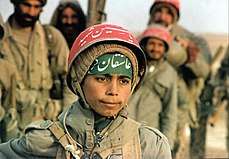Military operations of the Iran–Iraq War
Military operations of the Iran–Iraq War are events that stretched over the period of Iran–Iraq War from 22 September 1980 to end of the war. Most of operations occurred in Kermanshah, Ilam, and Khuzestan.[1]
1980: Iraqi invasion
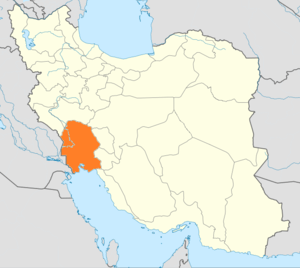
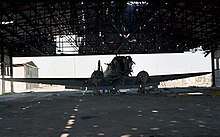
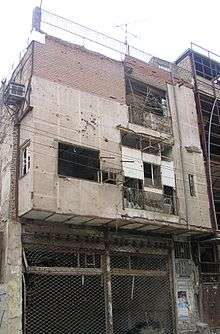
Iraq launched a full-scale invasion of Iran on 22 September 1980. The Iraqi Air Force launched surprise air strikes on ten Iranian airfields with the objective of destroying the Iranian Air Force.[2] The attack failed to damage the Iranian Air Force significantly: it damaged some of Iran's airbase infrastructure, but failed to destroy a significant number of aircraft: the Iraqi Air Force was only able to strike in depth with a few MiG-23BN, Tu-22, and Su-20 aircraft,[3] and Iran had built hardened aircraft shelters where most of its combat aircraft were stored.
The next day, Iraq launched a ground invasion along a front measuring 644 km (400 mi) in three simultaneous attacks.[2] The invasion's purpose, according to Saddam, was to blunt the edge of Khomeini's movement and to thwart his attempts to export his Islamic revolution to Iraq and the Persian Gulf states.[4] Saddam hoped that by annexing Khuzestan, he would send such a blow to Iran's prestige that it would lead to the new government's downfall, or, at the very least, end Iran's calls for his overthrow.[2]
Of Iraq's six divisions that were invading by ground, four were sent to Khuzestan, which was located near the border's southern end, to cut off the Shatt al-Arab [note 1] from the rest of Iran and to establish a territorial security zone.[2]:22 The other two divisions invaded across the northern and central part of the border to prevent an Iranian counter-attack.[2] Two of the four Iraqi divisions, one mechanised and one armoured, operated near the southern end and began a siege of the strategically important port cities of Abadan and Khorramshahr.[2]:22
The two armoured divisions secured the territory bounded by the cities of Khorramshahr, Ahvaz, Susangerd, and Musian.[2]:22 On the central front, the Iraqis occupied Mehran, advanced towards the foothills of the Zagros Mountains, and were able to block the traditional Tehran–Baghdad invasion route by securing territory forward of Qasr-e Shirin, Iran.[2]:23 On the northern front, the Iraqis attempted to establish a strong defensive position opposite Suleimaniya to protect the Iraqi Kirkuk oil complex.[2]:23 Iraqi hopes of an uprising by the ethnic Arabs of Khuzestan failed to materialise, as most of the ethnic Arabs remained loyal to Iran.[2] The Iraqi troops advancing into Iran in 1980 were described by Patrick Brogan as "badly led and lacking in offensive spirit".[5] The first known chemical weapons attack by Iraq on Iran probably took place during the fighting around Susangerd.[6]
Though the Iraqi air invasion surprised the Iranians, the Iranian air force retaliated the day after with a large-scale attack against Iraqi air bases and infrastructure in Operation Kaman 99. Groups of F-4 Phantom and F-5 Tiger fighter jets attacked targets throughout Iraq, such as oil facilities, dams, petrochemical plants, and oil refineries, and included Mosul Airbase, Baghdad, and the Kirkuk oil refinery. Iraq was taken by surprise at the strength of the retaliation which caused the Iraqis heavy losses and economic disruption, but the Iranians took heavy losses as well as they lost many aircraft and aircrews to Iraqi air defenses.
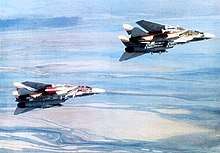
Iranian Army Aviation's AH-1 Cobra helicopter gunships began attacks on the advancing Iraqi divisions, along with F-4 Phantoms armed with Maverick missiles;[7] they destroyed numerous armoured vehicles and impeded the Iraqi advance, though not completely halting it.[8][9] Meanwhile, Iraqi air attacks on Iran were repulsed by Iran's F-14 Tomcat interceptor fighter jets, using Phoenix missiles, which downed a dozen of Iraq's Soviet-built fighters in the first two days of battle.[8]
The Iranian regular military, police forces, volunteer Basij, and Revolutionary Guards all conducted their operations separately; thus, the Iraqi invading forces did not face coordinated resistance.[2] However, on 24 September, the Iranian Navy attacked Basra, Iraq, destroying two oil terminals near the Iraqi port Faw, which reduced Iraq's ability to export oil.[2] The Iranian ground forces (primarily consisting of the Revolutionary Guard) retreated to the cities, where they set up defences against the invaders.[10]
On 30 September, Iran's air force launched Operation Scorch Sword, striking and badly damaging the nearly-complete Osirak nuclear reactor near Baghdad.[2] By 1 October, Baghdad had been subjected to eight air attacks.[2]:29 In response, Iraq launched aerial strikes against Iranian targets.[2][8]
The mountainous border between Iran and Iraq made a deep ground invasion almost impossible,[11] and air strikes were used instead. The invasion's first waves were a series of air strikes targeted at Iranian airfields. Iraq also attempted to bomb Tehran, Iran's capital and command centre, into submission.[2][3]
First Battle of Khorramshahr
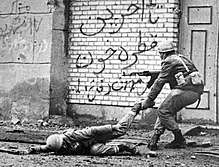
On 22 September, a prolonged battle began in the city of Khorramshahr, eventually leaving 7,000 dead on each side.[2] Reflecting the bloody nature of the struggle, Iranians came to call Khorramshahr "City of Blood".[2]
The battle began with Iraqi air raids against key points and mechanised divisions advancing on the city in a crescent-like formation. They were slowed by Iranian air attacks and Revolutionary Guard troops with recoilless rifles, rocket-propelled grenades, and Molotov cocktails.[12] The Iranians flooded the marsh areas around the city, forcing the Iraqis to traverse through narrow strips of land.[12] Iraqi tanks launched attacks with no infantry support, and many tanks were lost to Iranian anti-tank teams.[12] However, by 30 September, the Iraqis had managed to clear the Iranians from the outskirts of the city. The next day, the Iraqis launched infantry and armoured attacks into the city. After heavy house-to-house fighting, the Iraqis were repelled. On 14 October, the Iraqis launched a second offensive. The Iranians launched a controlled withdrawal from the city, street by street.[12] By 24 October, most of the city was captured, and the Iranians evacuated across the Karun River. Some partisans remained, and fighting continued until 10 November.
Iraqi advance stalls
The people of Iran, rather than turning against their still-weak Islamic Republic, rallied around their country. An estimated 200,000 fresh troops had arrived at the front by November, many of them ideologically committed volunteers.[13]
Though Khorramshahr was finally captured, the battle had delayed the Iraqis enough to allow the large-scale deployment of the Iranian military.[2] In November, Saddam ordered his forces to advance towards Dezful and Ahvaz, and lay sieges to both cities. However, the Iraqi offensive had been badly damaged by Iranian militias and air power. Iran's air force had destroyed Iraq's army supply depots and fuel supplies, and was strangling the country through an aerial siege.[8] On the other hand, Iran's supplies had not been exhausted, despite sanctions, and the military often cannibalised spare parts from other equipment and began searching for parts on the black market. On 28 November, Iran launched Operation Morvarid (Pearl), a combined air and sea attack which destroyed 80% of Iraq's navy and all of its radar sites in the southern portion of the country. When Iraq laid siege to Abadan and dug its troops in around the city, it was unable to blockade the port, which allowed Iran to resupply Abadan by sea.[14]
Iraq's strategic reserves had been depleted, and by now it lacked the power to go on any major offensives until nearly the end of the war.[2] On 7 December, Hussein announced that Iraq was going on the defensive.[2] By the end of 1980, Iraq had destroyed about 500 Western-built Iranian tanks and captured 100 others.[15][16]
1981: Stalemate
1981: Stalemate
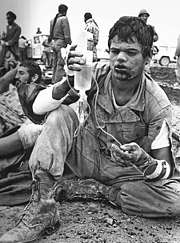
For the next eight months, both sides were to be on a defensive footing (with the exception of the Battle of Dezful), as the Iranians needed more time to reorganise their forces after the damage inflicted by the purge of 1979–80.[2] During this period, fighting consisted mainly of artillery duels and raids.[2] Iraq had mobilised 21 divisions for the invasion, while Iran countered with only 13 regular army divisions and one brigade. Of the regular divisions, only seven were deployed to the border. The war bogged down into World War I-style trench warfare with tanks and modern late-20th century weapons. Due to the power of anti-tank weapons such as the RPG-7, armored manoeuvre by the Iraqis was very costly, and they consequently entrenched their tanks into static positions.[7][17]
Iraq also began firing Scud missiles into Dezful and Ahvaz, and used terror bombing to bring the war to the Iranian civilian population.[14] Iran launched dozens of "human wave assaults".
Battle of Dezful
On 5 January 1981, Iran had reorganised its forces enough to launch a large-scale offensive, Operation Nasr (Victory).[12][18][19] The Iranians launched their major armoured offensive from Dezful in the direction of Susangerd, consisting of tank brigades from the 16th Qazvin, 77th Khorasan, and 92nd Khuzestan armoured divisions,[19] and broke through Iraqi lines.[2]:32 However, the Iranian tanks had raced through Iraqi lines with their flanks unprotected and with no infantry support;[7] as a result, they were cut off by Iraqi tanks.[2] In the ensuing Battle of Dezful, the Iranian armoured divisions were nearly wiped out in one of the biggest tank battles of the war.[2] When the Iranian tanks tried to manoeuvre, they became stuck in the mud of the marshes, and many tanks were abandoned.[12] The Iraqis lost 45 T-55 and T-62 tanks, while the Iranians lost 100–200 Chieftain and M-60 tanks. Reporters counted roughly 150 destroyed or deserted Iranian tanks, and also 40 Iraqi tanks.[2] 141 Iranians were killed during the battle.[19]
The battle had been ordered by Iranian president Abulhassan Banisadr, who was hoping that a victory might shore up his deteriorating political position; instead, the failure hastened his fall.[2]:71 Many of Iran's problems took place because of political infighting between President Banisadr, who supported the regular army, and the hardliners who supported the IRGC. Once he was impeached and the competition ended, the performance of the Iranian military improved. Iran was further distracted by internal fighting between the regime and the Islamic Marxist Mujaheddin e-Khalq (MEK) on the streets of Iran's major cities in June 1981 and again in September.[5]:250–251 After the end of these battles, the MEK gradually leaned towards Saddam, completely taking his side by the mid-1980s..
The People's Mujahedin of Iran started to take the side of Saddam in 1984 or 1986 (mid 1980s).[20] In 1986, Rajavi moved from Paris to Iraq and set up a base on the Iranian border.[21] The Battle of Dezful became a critical battle in Iranian military thinking. Less emphasis was placed on the Army with its conventional tactics, and more emphasis was placed on the Revolutionary Guard with its unconventional tactics.[12][22]
Attack on H3
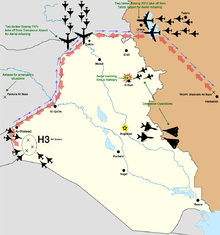
The Iraqi Air Force, badly damaged by the Iranians, was moved to the H-3 Airbase in Western Iraq, near the Jordanian border and away from Iran. However, on 3 April 1981, the Iranian air force used eight F-4 Phantom fighter bombers, four F-14 Tomcats, three Boeing 707 refuelling tankers, and one Boeing 747 command plane to launch a surprise attack on H3, destroying 27–50 Iraqi fighter jets and bombers.[23]
Despite the successful H-3 airbase attack (in addition to other air attacks), in April, the Iranian Air Force was forced to cancel its successful 180-day air offensive. In addition, they gave up trying to hold total control of Iranian airspace. Due to the heavy toll of sanctions and pre-war purges, the Iranian Air Force could not suffer further attrition, and made the decision in order to limit their losses. They were also damaged by a fresh purge, after the impeachment crisis of President Banisadr.[24] The Iranian air force would fight heavily on the defensive, trying to hold back the Iraqis rather than engaging them. While throughout 1981–1982 the Iraqi air force would remain weak, within the next few years they would rearm and expand again, and begin to regain the strategic initiative.[25]
Introduction of the human wave attack
Since the Iranians suffered from a shortage of heavy weapons[17]:225 but had a large number of devoted volunteer troops, they began using human wave attacks against the Iraqis. Typically, an Iranian assault would commence with poorly trained Basij who would launch the primary human wave assaults to swamp the weakest portions of the Iraqi lines en masse (on some occasions even bodily clearing minefields).[17][26] This would be followed up by the more experienced Revolutionary Guard infantry, who would breach the weakened Iraqi lines,[17][10] and followed up by the regular army using mechanized forces, who would maneuver through the breach and attempt to encircle and defeat the enemy.[17][12]
According to historian Stephen C. Pelletiere, the idea of Iranian "human wave attacks" was a misconception.[27] Instead, the Iranian tactics consisted of using groups of 22 man infantry squads, which moved forward to attack specific objectives. As the squads surged forward to execute their missions, that gave the impression of a "human wave attack". Nevertheless, the idea of "human wave attacks" remained virtually synonymous with any large-scale infantry frontal assault Iran carried out.[27] Large numbers of troops would be used, aimed at overwhelming the Iraqi lines (usually the weakest portion manned by the Iraqi Popular Army) regardless of losses.[17]
According to the former Iraqi general Ra'ad al-Hamdani, the Iranian human wave charges consisted of armed "civilians" who carried most of their necessary equipment themselves into battle and often lacked command and control and logistics.[28] Operations were often carried out during the night and deception operations, infiltrations, and maneuvers became more common.[14] The Iranians would also reinforce the infiltrating forces with new units to keep up their momentum. Once a weak point was found, the Iranians would concentrate all of their forces into that area in an attempt to break through with human wave attacks.[28]
The human wave attacks, while extremely bloody (tens of thousands of troops died in the process),[26] when used in combination with infiltration and surprise, caused major Iraqi defeats. As the Iraqis would dig in their tanks and infantry into static, entrenched positions, the Iranians would manage to break through the lines and encircle entire divisions.[17] Merely the fact that the Iranian forces used maneuver warfare by their light infantry against static Iraqi defenses was often the decisive factor in the battle.[10] However, lack of coordination between the Iranian Army and IRGC and shortages of heavy weaponry played a detrimental role, often with most of the infantry not being supported by artillery and armor.[17][10]
Operation Eighth Imam
After the Iraqi offensive stalled in March 1981, there was little change in the front other than Iran retaking the high ground above Susangerd in May. By late 1981, Iran returned to the offensive and launched a new operation (Operation Samen-ol-A'emeh (The Eighth Imam)),[29] ending the Iraqi Siege of Abadan on 27–29 September 1981.[2]:9 The Iranians used a combined force of regular army artillery with small groups of armor, supported by Pasdaran and Basij infantry.[24] On 15 October, after breaking the siege, a large Iranian convoy was ambushed by Iraqi tanks and during the ensuing tank battle Iran lost 20 Chieftains and other armored vehicles and withdrew from the previously gained territory.[30]
Operation Tariq al-Qods
On 29 November 1981, Iran began Operation Tariq al-Qods with three army brigades and seven Revolutionary Guard brigades. The Iraqis failed to properly patrol their occupied areas, and the Iranians constructed a 14 km (14,000 m; 8.7 mi) road through the unguarded sand dunes, launching their attack from the Iraqi rear.[12] The battle saw the town of Bostan being retaken from Iraqi divisions by 7 December.[2]:10 By this time the Iraqi Army was experiencing serious morale problems,[2] which was compounded by the fact that Operation Tariq al-Qods saw the first use of the Iranian "human wave" tactics, where the Revolutionary Guard light infantry repeatedly charged at Iraqi positions, oftentimes without the support of armour or air power.[2] The fall of Bostan exacerbated the Iraqis' logistical problems, forcing them to use a roundabout route from Ahvaz to the south to resupply their troops.[2] 6,000 Iranians and over 2,000 Iraqis were killed in this operation.[2]
1982: Iraqi retreat, Iranian offensive
The Iraqis, realising that the Iranians were planning to attack, decided to preempt them with Operation al-Fawz al-'Azim (Supreme Success)[31] on 19 March. Using a large number of tanks, helicopters, and fighter jets, they attacked the Iranian buildup around the Roghabiyeh pass. Though Saddam and his generals assumed they had succeeded, in reality the Iranian forces remained fully intact.[7] The Iranians had concentrated much of their forces by bringing them directly from the cities and towns throughout Iran via trains, buses, and private cars. The concentration of forces did not resemble a traditional military buildup, and although the Iraqis detected a population buildup near the front, they failed to realise that this was an attacking force.[28] As a result, Saddam's army was unprepared for the Iranian offensives to come.[7]
Operation Undeniable Victory
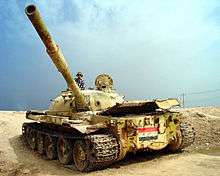
Iran's next major offensive, led by then Colonel Ali Sayad Shirazi, was Operation Fath-ol-Mobeen (Undeniable Victory). On 22 March 1982, Iran launched an attack which took the Iraqi forces by surprise: using Chinook helicopters, they landed behind Iraqi lines, silenced their artillery, and captured an Iraqi headquarters.[7] The Iranian Basij then launched "human wave" attacks, consisting of 1,000 fighters per wave. Though they took heavy losses, they eventually broke through Iraqi lines.
The Revolutionary Guard and regular army followed up by surrounding the Iraqi 9th and 10th Armoured and 1st Mechanised divisions that had camped close to the Iranian town of Shush. The Iraqis launched a counter-attack using their 12th Armoured division to break the encirclement and rescue the surrounded divisions. Iraqi tanks came under attack by 95 Iranian F-4 Phantom and F-5 Tiger fighter jets, destroying much of the division.[32]
Operation Undeniable Victory was an Iranian victory; Iraqi forces were driven away from Shush, Dezful and Ahvaz. The Iranian armed forces destroyed 320–400 Iraqi tanks and armored vehicles in a costly success. In just the first day of the battle, the Iranians lost 196 tanks.[7] By this time, most of the Khuzestan province had been recaptured.[2]
Operation Beit ol-Moqaddas
In preparation for Operation Beit ol-Moqaddas, the Iranians had launched numerous air raids against Iraq air bases, destroying 47 jets (including Iraq's brand new Mirage F-1 fighter jets from France); this gave the Iranians air superiority over the battlefield while allowing them to monitor Iraqi troop movements.[7]
On 29 April, Iran launched the offensive. 70,000 Revolutionary Guard and Basij members struck on several axes – Bostan, Susangerd, the west bank of the Karun River, and Ahvaz. The Basij launched human wave attacks, which were followed up by the regular army and Revolutionary Guard support along with tanks and helicopters.[7] Under heavy Iranian pressure, the Iraqi forces retreated. By 12 May, Iran had driven out all Iraqi forces from the Susangerd area.[2]:36 The Iranians captured several thousand Iraqi troops and a large number of tanks.[7] Nevertheless, the Iranians took many losses as well, especially among the Basij.
The Iraqis retreated to the Karun River, with only Khorramshahr and a few outlying areas remaining in their possession.[17] Saddam ordered 70,000 troops to be placed around the city of Khorramshahr. The Iraqis created a hastily constructed defence line around the city and outlying areas.[7] To discourage airborne commando landings, the Iraqis also placed metal spikes and destroyed cars in areas likely to be used as troop landing zones. Saddam Hussein even visited Khorramshahr in a dramatic gesture, swearing that the city would never be relinquished.[7] However, Khorramshahr's only resupply point was across the Shatt al-Arab,[note 1] and the Iranian air force began bombing the supply bridges to the city, while their artillery zeroed in on the besieged garrison.
Liberation of Khorramshahr (Second Battle of Khorramshahr)
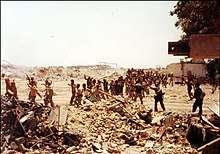
In the early morning hours of 23 May 1982, the Iranians began the drive towards Khorramshahr across the Karun River.[2] This part of Operation Beit ol-Moqaddas was spearheaded by the 77th Khorasan division with tanks along with the Revolutionary Guard and Basij. The Iranians hit the Iraqis with destructive air strikes and massive artillery barrages, crossed the Karun River, captured bridgeheads, and launched human wave attacks towards the city. Saddam's defensive barricade collapsed;[7] in less than 48 hours of fighting, the city fell and 19,000 Iraqis surrendered to the Iranians. A total of 10,000 Iraqis were killed or wounded in Khorramshahr, while the Iranians suffered 30,000 casualties.[33] During the whole of Operation Beit ol-Moqaddas, 33,000 Iraqi soldiers were captured by the Iranians.[7]
State of Iraqi armed forces
The fighting had battered the Iraqi military: its strength fell from 210,000 to 150,000 troops; over 20,000 Iraqi soldiers were killed and over 30,000 captured; two out of four active armoured divisions and at least three mechanised divisions fell to less than a brigade's strength; and the Iranians had captured over 450 tanks and armoured personnel carriers.[34]
The Iraqi Air Force was also left in poor shape: after losing up to 55 aircraft since early December 1981, they had only 100 intact fighter-bombers and interceptors. A defector who flew his MiG-21 to Syria in June 1982 revealed that the Iraqi Air Force had only three squadrons of fighter-bombers left that were capable of mounting offensive operations into Iran. The Iraqi Army Air Corps was in slightly better shape, and could still operate more than 70 helicopters.[34] Despite this, the Iraqis still held 3,000 tanks, while Iran held 1,000.[7]
At this point, Saddam believed that his army was too demoralised and damaged to hold onto Khuzestan and major swathes of territory in Iran, and withdrew his remaining armed forces from those areas. He redeployed them along the border with Iran as a means of defence.[2] However, his troops continued to occupy some key border areas of Iran, and continued to hold onto the disputed territories that prompted his invasion, including the Shatt al-Arab waterway.[7][35] In response to their failures against the Iranians in Khorramshahr, Saddam ordered the executions of General Juwad Shitnah, General Salah al-Qadhi, and Colonel Masa and al-Jalil.[28] At least a dozen high-ranking officers were also executed during this time.[24] This became an increasingly common punishment for those who failed him in battle.[28]
International response in 1982
In April 1982, the rival Ba'athist regime in Syria, one of the few nations that supported Iran, closed the Kirkuk–Baniyas pipeline that had allowed Iraqi oil to reach tankers on the Mediterranean, reducing the Iraqi budget by $5 billion per month.[2] Journalist Patrick Brogan wrote, "It appeared for a while that Iraq would be strangled economically before it was defeated militarily."[5]:260 Syria's closure of the Kirkuk–Baniyas pipeline left Iraq with the pipeline to Turkey as the only means of exporting oil. However, that pipeline had a capacity of only 500,000 barrels per day (79,000 m3/d), which was insufficient to pay for the war.[36]:160 However, Saudi Arabia, Kuwait, and the other Gulf states saved Iraq from bankruptcy[2] by providing it with an average of $60 billion in subsidies per year.[5]:263 Though Iraq had previously been hostile towards other Gulf states, "the threat of Persian fundamentalism was far more feared."[36]:162–163[5]:263 They were especially inclined to fear Iranian victory after Ayatollah Khomeini declared monarchies to be illegitimate and an un-Islamic form of government.[2] Khomeini's statement was widely received as a call to overthrow the Gulf monarchies.[2] Journalists John Bulloch and Harvey Morris wrote:
The virulent Iranian campaign, which at its peak seemed to be making the overthrow of the Saudi regime a war aim on a par with the defeat of Iraq, did have an effect on the Kingdom [of Saudi Arabia], but not the one the Iranians wanted: instead of becoming more conciliatory, the Saudis became tougher, more self-confident, and less prone to seek compromise.[36]:163
Saudi Arabia was said to provide Iraq with $1 billion per month starting in mid-1982.[36]:160
Iraq began receiving support from the United States and west European countries as well. Saddam was given diplomatic, monetary, and military support by the United States, including massive loans, political influence, and intelligence on Iranian deployments gathered by American spy satellites.[37] The Iraqis relied heavily on American satellite footage and radar planes to detect Iranian troop movements, and they enabled Iraq to move troops to the site before the battle.[38]
With Iranian success on the battlefield, the United States increased its support of the Iraqi government, supplying intelligence, economic aid, and dual-use equipment and vehicles, as well as normalizing its intergovernmental relations (which had been broken during the 1967 Six-Day War).[37] President Ronald Reagan decided that the United States "could not afford to allow Iraq to lose the war to Iran", and that the United States "would do whatever was necessary to prevent Iraq from losing".[39] Reagan formalised this policy by issuing a National Security Decision Directive to this effect in June 1982.
In 1982, Reagan removed Iraq from the list of countries "supporting terrorism" and sold weapons such as howitzers to Iraq via Jordan.[37] France sold Iraq millions of dollars worth of weapons, including Gazelle helicopters, Mirage F-1 fighters, and Exocet missiles. Both the United States and West Germany sold Iraq dual-use pesticides and poisons that would be used to create chemical[37] and other weapons, such as Roland missiles.
At the same time, the Soviet Union, angered with Iran for purging and destroying the communist Tudeh Party, sent large shipments of weapons to Iraq. The Iraqi Air Force was replenished with Soviet, Chinese, and French fighter jets and attack/transport helicopters. Iraq also replenished their stocks of small arms and anti-tank weapons such as AK-47s and rocket-propelled grenades from its supporters. The depleted tank forces were replenished with more Soviet and Chinese tanks, and the Iraqis were reinvigorated in the face of the coming Iranian onslaught. Iran was portrayed as the aggressor, and would be seen as such until the 1990–1991 Persian Gulf War, when Iraq would be condemned.
Iran did not have the money to purchase arms to the same extent as Iraq did. They counted on China, North Korea, Libya, Syria, and Japan for supplying anything from weapons and munitions to logistical and engineering equipment.[40] There were also clandestine purchases from certain elements within Israel and the United States, who also bought small arms from China, via North Korea.
Ceasefire proposal
On June 20, 1982, Saddam announced that he wanted to sue for peace and proposed an immediate ceasefire and withdrawal from Iranian territory within two weeks.[43] Khomeini responded by saying the war would not end until a new government was installed in Iraq and reparations paid.[44] He proclaimed that Iran would invade Iraq and would not stop until the Ba'ath regime was replaced by an Islamic republic.[2][35] Iran supported a government in exile for Iraq, the Supreme Council of the Islamic Revolution in Iraq, led by exiled Iraqi cleric Mohammad Baqer al-Hakim, which was dedicated to overthrowing the Ba'ath party. They recruited POW's, dissidents, exiles, and Shias to join the Badr Brigade, the military wing of the organisation.[7]
The decision to invade Iraq was taken after much debate within the Iranian government.[2] One faction, comprising Prime Minister Mir-Hossein Mousavi, Foreign Minister Ali Akbar Velayati, President Ali Khamenei, Army Chief of Staff General Ali Sayad Shirazi as well as Major General Qasem-Ali Zahirnejad, wanted to accept the ceasefire, as most of Iranian soil had been recaptured.[2] In particular, General Shirazi and Zahirnejad were both opposed to the invasion of Iraq on logistical grounds, and stated they would consider resigning if "unqualified people continued to meddle with the conduct of the war".[2]:38 Of the opposing view was a hardline faction led by the clerics on the Supreme Defence Council, whose leader was the politically powerful speaker of the Majlis, Akbar Hashemi Rafsanjani.[2]
Iran also hoped that their attacks would ignite a revolt against Saddam's rule by the Shia and Kurdish population of Iraq, possibly resulting in his downfall. They were successful in doing so with the Kurdish population, but not the Shia.[7] Iran had captured large quantities of Iraqi equipment (enough to create several tank battalions, Iran once again had 1,000 tanks) and also managed to clandestinely procure spare parts as well.[17]
At a cabinet meeting in Baghdad, Minister of Health Riyadh Ibrahim Hussein suggested that Saddam could step down temporarily as a way of easing Iran towards a ceasefire, and then afterwards would come back to power.[36]:147 Saddam, annoyed, asked if anyone else in the Cabinet agreed with the Health Minister's idea. When no one raised their hand in support, he escorted Riyadh Hussein to the next room, closed the door, and shot him with his pistol.[36]:147 Saddam returned to the room and continued with his meeting.
Iran invades Iraq
Iraqi tactics against Iranian invasion
For the most part, Iraq remained on the defensive for the next six years, unable and unwilling to launch any major offensives, while Iran launched more than 70 offensives. Iraq's strategy changed from holding territory in Iran to denying Iran any major gains in Iraq (as well as holding onto disputed territories and Iran's border areas).[37] Saddam commenced a policy of total war, gearing most of his country towards defending against Iran. By 1988, Iraq was spending 40–75% of its GDP on military equipment.[45] Saddam had also more than doubled the size of the Iraqi army, from 200,000 soldiers (12 divisions and 3 independent brigades) to 500,000 (23 divisions and nine brigades).[2] They also began launching air raids against Iranian border cities, greatly increasing the practice by 1984. By the end of 1982, Iraq had been resupplied with new Soviet and Chinese materiel, and the ground war entered a new phase. Iraq used newly acquired T-55, T-62 and T-72 tanks (as well as Chinese copies), BM-21 truck-mounted rocket launchers, and Mi-24 helicopter gunships to prepare a Soviet-type three-line defence, replete with obstacles such as barbed wire, minefields, fortified positions and bunkers. The Combat Engineer Corps built bridges across water obstacles, laid minefields, erected earthen revetments, dug trenches, built machinegun nests, and prepared new defence lines and fortifications.[37]:2
Iraq began to focus on using defense in depth to defeat the Iranians.[17] Iraq created multiple static defense lines to bleed the Iranians through sheer size.[17] When faced against large Iranian attack, where human waves would overrun Iraq's entrenched infantry defences, the Iraqis would often retreat, but their static defences would bleed the Iranians and channel them into certain directions, drawing them into traps or pockets. Iraqi air and artillery attacks would then pin the Iranians down, while tanks and mechanised infantry attacks using mobile warfare would push them back.[38] Sometimes, the Iraqis would launch "probing attacks" into the Iranian lines to provoke them into launching their attacks sooner. While Iranian human wave attacks were successful against the dug in Iraqi forces in Khuzestan, they had trouble breaking through Iraq's defense in depth lines.[7] Iraq had a logistical advantage in their defence: the front was located near the main Iraqi bases and arms depots, allowing their army to be efficiently supplied.[5]:260,265 By contrast, the front in Iran was a considerable distance away from the main Iranian bases and arms depots, and as such, Iranian troops and supplies had to travel through mountain ranges before arriving at the front.[5]:260
In addition, Iran's military power was weakened once again by large purges in 1982, resulting from another supposedly attempted coup.[46]
Operation Ramadan (First Battle of Basra)
The Iranian generals wanted to launch an all-out attack on Baghdad and seize it before the weapon shortages continued to manifest further. Instead, that was rejected as being unfeasable,[35] and the decision was made to capture one area of Iraq after the other in the hopes that a series of blows delivered foremost by the Revolutionary Guards Corps would force a political solution to the war (including Iraq withdrawing completely from the disputed territories along the border).[35]
The Iranians planned their attack in southern Iraq, near Basra.[2] Called Operation Ramadan, it involved over 180,000 troops from both sides, and was one of the largest land battles since World War II.[37]:3 Iranian strategy dictated that they launch their primary attack on the weakest point of the Iraqi lines; however, the Iraqis were informed of Iran's battle plans and moved all of their forces to the area the Iranians planned to attack.[34] The Iraqis were equipped with tear gas to use against the enemy, which would be first major use of chemical warfare during the conflict, throwing an entire attacking division into chaos.[46]
Over 100,000 Revolutionary Guards and Basij volunteer forces charged towards the Iraqi lines.[2] The Iraqi troops had entrenched themselves in formidable defences, and had set up a network of bunkers and artillery positions.[2] The Basij used human waves, and were even used to bodily clear the Iraqi minefields and allow the Revolutionary Guards to advance.[2] Combatants came so close to one another that Iranians were able to board Iraqi tanks and throw grenades inside the hulls. By the eighth day, the Iranians had gained 16 km (9.9 mi) inside Iraq and had taken several causeways. Iran's Revolutionary Guards also used the T-55 tanks they had captured in earlier battles.[17]
However, the attacks came to a halt and the Iranians turned to defensive measures. Seeing this, Iraq used their Mi-25 helicopters, along with Gazelle helicopters armed with Euromissile HOT, against columns of Iranian mechanised infantry and tanks. These "hunter-killer" teams of helicopters, which had been formed with the help of East German advisors, proved to be very costly for Iranians. Aerial dogfights occurred between Iraqi MiGs and Iranian F-4 Phantoms.[46]
On 16 July, Iran tried again further north and managed to push the Iraqis back. However, only 13 km (8.1 mi) from Basra, the poorly equipped Iranian forces were surrounded on three sides by Iraqis with heavy weaponry. Some were captured, while many were killed. Only a last-minute attack by Iranian AH-1 Cobra helicopters stopped the Iraqis from routing the Iranians.[34] Three more similar attacks occurred around the Khorramshar-Baghdad road area towards the end of the month, but none were significantly successful.[17] Iraq had concentrated three armoured divisions, the 3rd, 9th, and 10th, as a counter-attack force to attack any penetrations. They were successful in defeating the Iranian breakthroughs, but suffered heavy losses. The 9th Armoured Division in particular had to be disbanded, and was never reformed. The total casualty toll had grown to include 80,000 soldiers and civilians. 400 Iranian tanks and armored vehicles were destroyed or abandoned, while Iraq lost no fewer than 370 tanks.[47][48]
Fighting during the rest of 1982
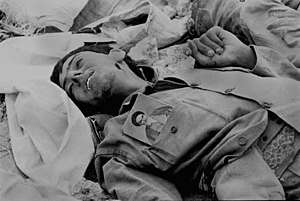
After Iran's failure in Operation Ramadan, they carried out only a few smaller attacks. Iran launched two limited offensives aimed at reclaiming the Sumar Hills and isolating the Iraqi pocket at Naft Shahr at the international border, both of which were part of the disputed territories still under Iraqi occupation. They then aimed to capture the Iraqi border town of Mandali.[34] They planned to take the Iraqis by surprise using Basij militiamen, army helicopters, and some armoured forces, then stretch their defences and possibly break through them to open a road to Baghdad for future exploitation.[34] During Operation Muslim ibn Aqil (1–7 October),[note 2] Iran recovered 150 km2 (58 sq mi) of disputed territory straddling the international border and reached the outskirts of Mandali before being stopped by Iraqi helicopter and armoured attacks.[14][34] During Operation Muharram (1–21 November),[note 3] the Iranians captured part of the Bayat oilfield with the help of their fighter jets and helicopters, destroying 105 Iraqi tanks, 70 APCs, and 7 planes with few losses. They nearly breached the Iraqi lines but failed to capture Mandali after the Iraqis sent reinforcements, including brand new T-72 tanks, which possessed armour that could not be pierced from the front by Iranian TOW missiles.[34] The Iranian advance was also impeded by heavy rains. 3,500 Iraqis and an unknown number of Iranians died, with only minor gains for Iran.[34]
1983–84: Strategic stalemate and war of attrition
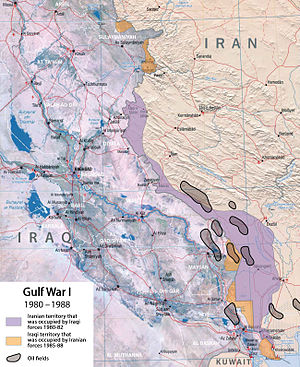
After the failure of the 1982 summer offensives, Iran believed that a major effort along the entire breadth of the front would yield victory. During the course of 1983, the Iranians launched five major assaults along the front, though none achieved substantial success, as the Iranians staged more massive "human wave" attacks.[2] By this time, it was estimated that no more than 70 Iranian fighter aircraft were still operational at any given time; Iran had its own helicopter repair facilities, left over from before the revolution, and thus often used helicopters for close air support.[34][50] While Iranian fighter pilots had superior training compared to their Iraqi counterparts (as most had received training from US officers before the 1979 revolution)[51] and would continue to dominate in combat,[52] aircraft shortages, the size of defended territory and American intelligence supplied to Iraq allowed the Iraqis to exploit gaps in Iranian airspace. Iraqi air campaigns met little opposition, striking over half of Iran, and the Iraqis were able to gain air superiority towards the end of the war.
Operation Before the Dawn
Operation Fajr al-Nasr (Before the Dawn/Dawn of Victory), launched 6 February 1983, saw the Iranians shift focus from the southern to the central and northern sectors. Iran, using 200,000 "last reserve" Revolutionary Guard troops, attacked along a 40 km (25 mi) stretch near al-Amarah, Iraq about 200 km (120 mi) southeast of Baghdad, in an attempt to reach the highways connecting northern and southern Iraq. The attack was stalled by 60 km (37 mi) of hilly escarpments, forests, and river torrents blanketing the way to al-Amarah, but the Iraqis could not force the Iranians back. Iran directed artillery on Basra and Al Amarah, and Mandali.[50]
The Iranians suffered a large number of casualties clearing minefields and breaching Iraqi anti-tank mines, which Iraqi engineers were unable to replace. After this battle, Iran reduced its use of human wave attacks, though they still remained a key tactic as the war went on.[50]
The Mandali–Baghdad northcentral sector also witnessed fighting in April 1983, as Iranian attacks were stopped by Iraqi mechanised and infantry divisions. Casualties were high, and by the end of 1983, an estimated 120,000 Iranians and 60,000 Iraqis had been killed. Iran, however, held the advantage in the war of attrition.[37]:2
Dawn Operations
From early 1983–1984, Iran launched a series of four Valfajr (Dawn) Operations (that eventually numbered to 10). During Operation Dawn-1, in early February 1983, 50,000 Iranian forces attacked westward from Dezful and were confronted by 55,000 Iraqi forces. The Iranian objective was to cut off the road from Basra to Baghdad in the central sector. The Iraqis carried out 150 air sorties against the Iranians, and even bombed Dezful, Ahvaz, and Khorramshahr in retribution. The Iraqi counterattack was broken up by Iran's 92nd Armoured Division.[50]
During Operation Dawn-2, the Iranian's directed insurgency operations by proxy in April 1983 by supporting the Kurds in the north. With Kurdish support, the Iranians attacked on 23 July 1983, capturing the Iraqi town of Haj Omran and maintaining it against an Iraqi poison gas counteroffensive.[53] This operation incited Iraq to later conduct indiscriminate chemical attacks against the Kurds.[50] The Iranians attempted to further exploit activities in the north on 30 July 1983, during Operation Dawn-3. Iran saw an opportunity to sweep away Iraqi forces controlling the roads between the Iranian mountain border towns of Mehran, Dehloran and Elam. Iraq launched airstrikes, and equipped attack helicopters with chemical warheads; while ineffective, it demonstrated both the Iraqi general staff's and Saddam's increasing interest in using chemical weapons. In the end, 17,000 had been killed on both sides, with no gain for either country.[50]
The focus of Operation Dawn-4 in September 1983 was the northern sector in Iranian Kurdistan. Three Iranian regular divisions, the Revolutionary Guard, and Kurdistan Democratic Party (KDP) elements amassed in Marivan and Sardasht in a move to threaten the major Iraqi city Suleimaniyah. Iran's strategy was to press Kurdish tribes to occupy the Banjuin Valley, which was within 45 km (28 mi) of Suleimaniyah and 140 km (87 mi) from the oilfields of Kirkuk. To stem the tide, Iraq deployed Mi-8 attack helicopters equipped with chemical weapons and executed 120 sorties against the Iranian force, which stopped them 15 km (9.3 mi) into Iraqi territory. 5,000 Iranians and 2,500 Iraqis died.[50] Iran gained 110 km2 (42 sq mi) of its territory back in the north, gained 15 km2 (5.8 sq mi) of Iraqi land, and captured 1,800 Iraqi prisoners while Iraq abandoned large quantities of valuable weapons and war materiel in the field. Iraq responded to these losses by firing a series of SCUD-B missiles into the cities of Dezful, Masjid Soleiman, and Behbehan. Iran's use of artillery against Basra while the battles in the north raged created multiple fronts, which effectively confused and wore down Iraq.[50]
Iran's change in tactics
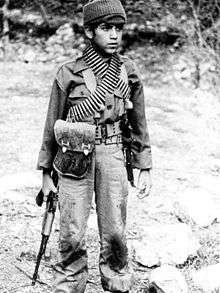
Previously, the Iranians had outnumbered the Iraqis on the battlefield, but Iraq expanded their military draft (pursuing a policy of total war), and by 1984, the armies were equal in size. By 1986, Iraq had twice as many soldiers as Iran. By 1988, Iraq would have 1 million soldiers, giving it the fourth largest army in the world. Some of their equipment, such as tanks, outnumbered the Iranians' by at least five to one. Iranian commanders, however, remained more tactically skilled.[17]
After the Dawn Operations, Iran attempted to change tactics. In the face of increasing Iraqi defense in depth, as well as increased armaments and manpower, Iran could no longer rely on simple human wave attacks.[12] Iranian offensives became more complex and involved extensive maneuver warfare using primarily light infantry. Iran launched frequent, and sometimes smaller offensives to slowly gain ground and deplete the Iraqis through attrition.[10] They wanted to drive Iraq into economic failure by wasting money on weapons and war mobilization, and to deplete their smaller population by bleeding them dry, in addition to creating an anti-government insurgency (they were successful in Kurdistan, but not southern Iraq).[7][10][46] Iran also supported their attacks with heavy weaponry when possible and with better planning (although the brunt of the battles still fell to the infantry). The Army and Revolutionary Guards worked together better as their tactics improved.[7] Human wave attacks became less frequent (although still used).[28] To negate the Iraqi advantage of defense in depth, static positions, and heavy firepower, Iran began to focus on fighting in areas where the Iraqis could not use their heavy weaponry, such as marshes, valleys, and mountains, and frequently using infiltration tactics.[28]
Iran began training troops in infiltration, patrolling, night-fighting, marsh warfare, and mountain warfare.[12] They also began training thousands of Revolutionary Guard commandos in amphibious warfare,[54] as southern Iraq is marshy and filled with wetlands. Iran used speedboats to cross the marshes and rivers in southern Iraq and landed troops on the opposing banks, where they would dig and set up pontoon bridges across the rivers and wetlands to allow heavy troops and supplies to cross. Iran also learned to integrate foreign guerrilla units as part of their military operations.[12] On the northern front, Iran began working heavily with the Peshmerga, Kurdish guerrillas.[12] Iranian military advisors organised the Kurds into raiding parties of 12 guerrillas, which would attack Iraqi command posts, troop formations, infrastructure (including roads and supply lines), and government buildings.[12] The oil refineries of Kirkuk became a favourite target, and were often hit by homemade Peshmerga rockets.[12]
Battle of the Marshes
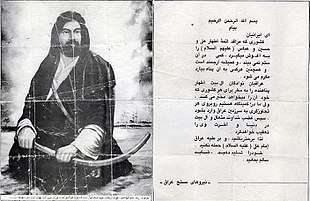
By 1984, the Iranian ground forces were reorganised well enough for the Revolutionary Guard to start Operation Kheibar,[50][55] which lasted from 24 February to 19 March.[36]:171 On 15 February 1984, the Iranians began launching attacks against the central section of the front, where the Second Iraqi Army Corps was deployed: 250,000 Iraqis faced 250,000 Iranians.[2] The goal of this new major offensive was the capture of Basra-Baghdad Highway, cutting off Basra from Baghdad and setting the stage for an eventual attack upon the city.[7] The Iraqi high command had assumed that the marshlands above Basra were natural barriers to attack, and had not reinforced them. The marshes negated Iraqi advantage in armor, and absorbed artillery rounds and bombs.[7] Prior to the attack, Iranian commandos on helicopters had landed behind Iraqi lines and destroyed Iraqi artillery. Iran launched two preliminary attacks prior to the main offensive, Operation Dawn 5 and Dawn 6.[50] They saw the Iranians attempting to capture Kut al-Imara, Iraq and sever the highway connecting Baghdad to Basra, which would impede Iraqi coordination of supplies and defences. Iranian troops crossed the river on motorboats in a surprise attack, though only came within 24 km (15 mi) of the highway.
Operation Kheibar began on 24 February with Iranian infantrymen crossing the Hawizeh Marshes using motorboats and transport helicopters in an amphibious assault.[7] The Iranians attacked the vital oil-producing Majnoon Island by landing troops via helicopters onto the islands and severing the communication lines between Amareh and Basra.[55] They then continued the attack towards Qurna.[7] By 27 February, they had captured the island, but suffered catastrophic helicopter losses to IRAF. On that day, a massive array of Iranian helicopters transporting Pasdaran troops were intercepted by Iraqi combat aircraft (MiGs, Mirages and Sukhois). In what was essentially an aerial slaughter, Iraqi jets shot down 49 of 50 Iranian helicopters.[7] At times, fighting took place in waters over 2 m (6.6 ft) deep. Iraq ran live electrical cables through the water, electrocuting numerous Iranian troops and then displaying their corpses on state television.[50]
By 29 February, the Iranians had reached the outskirts of Qurna and were closing in on the Baghdad–Basra highway.[7] They had broken out of the marshes and returned to open terrain, where they were confronted by conventional Iraqi weapons, including artillery, tanks, air power, and mustard gas. 1,200 Iranian soldiers were killed in the counter-attack. The Iranians retreated back to the marshes, though they still held onto them along with Majnoon Island.[7][2]:44
The Battle of the Marshes saw an Iraqi defence that had been under continuous strain since 15 February; they were relieved by their use of chemical weapons and defence-in-depth, where they layered defensive lines: even if the Iranians broke through the first line, they were usually unable to break through the second due to exhaustion and heavy losses.[36]:171 They also largely relied on Mi-24 Hind to "hunt" the Iranian troops in the marshes,[7] and at least 20,000 Iranians were killed in the marsh battles.[50] Iran used the marshes as a springboard for future attacks/infiltrations.[7]
Four years into the war, the human cost to Iran had been 170,000 combat fatalities and 340,000 wounded. Iraqi combat fatalities were estimated at 80,000 with 150,000 wounded.[7]
"Tanker War" and the "War of the Cities"
%2C_USS_William_H._Standley_(CG-32)_and_USS_Guadalcanal_(LPH-7)_escort_tanker_Gas_King_in_the_Persian_Gullf_on_21_October_1987_(6432283).jpg)
Unable to launch successful ground attacks against Iran, Iraq used their now expanded air force to carry out strategic bombing against Iranian shipping, economic targets, and cities in order to damage Iran's economy and morale.[7][56] Iraq also wanted to provoke Iran into doing something that would cause the superpowers to be directly involved in the conflict on the Iraqi side.[37]

Attacks on shipping
The so-called "Tanker War" started when Iraq attacked the oil terminal and oil tankers at Kharg Island in early 1984.[2] Iraq's aim in attacking Iranian shipping was to provoke the Iranians to retaliate with extreme measures, such as closing the Strait of Hormuz to all maritime traffic, thereby bringing American intervention; the United States had threatened several times to intervene if the Strait of Hormuz were closed.[2] As a result, the Iranians limited their retaliatory attacks to Iraqi shipping, leaving the strait open to general passage.[2]
Iraq declared that all ships going to or from Iranian ports in the northern zone of the Persian Gulf were subject to attack.[2] They used F-1 Mirage, Super Etendard, Mig-23, Su-20/22, and Super Frelon helicopters armed with Exocet anti-ship missiles as well as Soviet-made air-to-surface missiles to enforce their threats. Iraq repeatedly bombed Iran's main oil export facility on Kharg Island, causing increasingly heavy damage. As a first response to these attacks, Iran attacked a Kuwaiti tanker carrying Iraqi oil near Bahrain on 13 May 1984, as well as a Saudi tanker in Saudi waters on 16 May. Because Iraq had become landlocked during the invasion, they had to rely on their Arab allies, primarily Kuwait, to transport their oil. Iran attacked tankers carrying Iraqi oil from Kuwait, later attacking tankers from any Persian Gulf state supporting Iraq. Attacks on ships of noncombatant nations in the Persian Gulf sharply increased thereafter, with both nations attacking oil tankers and merchant ships of neutral nations in an effort to deprive their opponent of trade.[2] The Iranian attacks against Saudi shipping led to Saudi F-15s shooting down a pair of F-4 Phantom II on 5 June 1984.[2]
The air and small-boat attacks, however, did little damage to Persian Gulf state economies, and Iran moved its shipping port to Larak Island in the Strait of Hormuz.[57]
The Iranian Navy imposed a naval blockade of Iraq, using its British-built frigates to stop and inspect any ships thought to be trading with Iraq. They operated with virtual impunity, as Iraqi pilots had little training in hitting naval targets. Some Iranian warships attacked tankers with ship-to-ship missiles, while others used their radars to guide land-based anti-ship missiles to their targets.[58] Iran began to rely on its new Revolutionary Guard's navy, which used Boghammar speedboats fitted with rocket launchers and heavy machine guns. These speedboats would launch surprise attacks against tankers and cause substantial damage. Iran also used F-4 Phantoms II and helicopters to launch Maverick missiles and unguided rockets at tankers.[7]
A U.S. Navy ship, Stark, was struck on 17 May 1987 by two Exocet anti-ship missiles fired from an Iraqi F-1 Mirage plane.[59][60] The missiles had been fired at about the time the plane was given a routine radio warning by Stark.[61] The frigate did not detect the missiles with radar, and warning was given by the lookout only moments before they struck.[62] Both missiles hit the ship, and one exploded in crew quarters, killing 37 sailors and wounding 21.[62]
Lloyd's of London, a British insurance market, estimated that the Tanker War damaged 546 commercial vessels and killed about 430 civilian sailors. The largest portion of the attacks was directed by Iraq against vessels in Iranian waters, with the Iraqis launching three times as many attacks as the Iranians.[37]:3 But Iranian speedboat attacks on Kuwaiti shipping led Kuwait to formally petition foreign powers on 1 November 1986 to protect its shipping. The Soviet Union agreed to charter tankers starting in 1987, and the United States Navy offered to provide protection for foreign tankers reflagged and flying the U.S. flag starting 7 March 1987 in Operation Earnest Will.[2][61] Neutral tankers shipping to Iran were unsurprisingly not protected by Earnest Will, resulting in reduced foreign tanker traffic to Iran, since they risked Iraqi air attack. Iran accused the United States of helping Iraq.[7][37]
During the course of the war, Iran attacked two Soviet Navy ships which were protecting Kuwaiti tankers.[63]
Seawise Giant, the largest ship ever built, was struck and damaged by Iraqi Exocet missiles as it was carrying Iranian crude oil out of the Gulf.[64]
Attacks on cities
Meanwhile, Iraq's air force also began carrying out strategic bombing raids against Iranian cities. While Iraq had launched numerous attacks with aircraft and missiles against border cities from the beginning of the war and sporadic raids on Iran's main cities, this was the first systematic strategic bombing that Iraq carried out during the war. This would become known as the "War of the Cities". With the help of the USSR and the west, Iraq's air force had been rebuilt and expanded.[25] Meanwhile, Iran, due to sanctions and lack of spare parts, had heavily curtailed its air force operations. Iraq used Tu-22 Blinder and Tu-16 Badger strategic bombers to carry out long-range high-speed raids on Iranian cities, including Tehran. Fighter-bombers such as the Mig-25 Foxbat and Su-22 Fitter were used against smaller or shorter range targets, as well as escorting the strategic bombers.[25] Civilian and industrial targets were hit by the raids, and each successful raid inflicted economic damage from regular strategic bombing.[25]
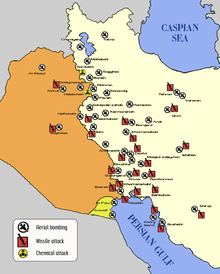
In response, the Iranians deployed their F-4 Phantoms to combat the Iraqis, and eventually they deployed F-14s as well. Most of the Iraqi air raids were intercepted by the Iranian fighter jets and air defense, but some also successfully hit their targets, becoming a major headache for Iran. By 1986, Iran also expanded their air defense network heavily to take the load of the fighting off the air force. By later in the war, Iraqi raids primarily consisted of indiscriminate missile attacks while air attacks were used only on fewer, more important targets.[65] Starting in 1987, Saddam also ordered several chemical attacks on civilian targets in Iran, such as the town of Sardasht.[66]
Iran also launched several retaliatory air raids on Iraq, while primarily shelling border cities such as Basra. Iran also bought some Scud missiles from Libya, and launched them against Baghdad. These too inflicted damage upon Iraq.[7]
On 7 February 1984, (during the first war of the cities) Saddam ordered his air force to attack eleven Iranian cities;[2] bombardments ceased on 22 February 1984. Though Saddam had aimed for the attacks to demoralise Iran and force them to negotiate, they had little effect, and Iran quickly repaired the damage. Iraq's air force took heavy losses, however, and Iran struck back, hitting Baghdad and other Iraqi cities. Nevertheless, the attacks resulted in tens of thousands of civilian casualties on both sides, and became known as the first "war of the cities". It was estimated that 1,200 Iranian civilians were killed during the raids in February alone.[7] There would be five such major exchanges throughout the course of the war, and multiple minor ones. While interior cities such as Tehran, Tabriz, Qom, Isfahan and Shiraz did receive numerous raids, it was the cities of western Iran that suffered the most death and destruction.
Strategic situation in 1984
By 1984, Iran's losses were estimated to be 300,000 soldiers, while Iraq's losses were estimated to be 150,000.[37]:2 Foreign analysts agreed that both Iran and Iraq failed to use their modern equipment properly, and both sides failed to carry out modern military assaults that could win the war. Both sides also abandoned equipment in the battlefield because their technicians were unable to carry out repairs. Iran and Iraq showed little internal coordination on the battlefield, and in many cases units were left to fight on their own. As a result, by the end of 1984, the war was a stalemate.[37]:2
[67] One limited offensive Iran launched (Dawn 7) took place from 18–25 October 1984, when they recaptured the Iranian city of Mehran, which had been occupied by the Iraqis from the beginning of the war.[2][46]
1985–86: Offensives and retreats
By 1985, Iraqi armed forces were receiving financial support from Saudi Arabia, Kuwait, and other Persian Gulf states, and were making substantial arms purchases from the Soviet Union, China, and France. For the first time since early 1980, Saddam launched new offensives.
On 6 January 1986, the Iraqis launched an offensive attempting to retake Majnoon Island. However, they were quickly bogged down into a stalemate against 200,000 Iranian infantrymen, reinforced by amphibious divisions.[50] However, they managed to gain a foothold in the southern part of the island.[3]
Iraq also carried out another "war of the cities" between 12–14 March, hitting up to 158 targets in over 30 towns and cities, including Tehran. Iran responded by launching 14 Scud missiles for the first time, purchased from Libya. More Iraqi air attacks were carried out in August, resulting in hundreds of additional civilian casualties. Iraqi attacks against both Iranian and neutral oil tankers in Iranian waters continued, with Iraq carrying out 150 airstrikes using French bought Super Etendard and Mirage F-1 jets as well as Super Frelon helicopters, using Exocet missiles.[56]
Operation Badr
The Iraqis attacked again on 28 January 1985; they were defeated, and the Iranians retaliated on 11 March 1985 with a major offensive directed against the Baghdad-Basra highway (one of the few major offensives conducted in 1985), codenamed Operation Badr (after the Battle of Badr, Muhammad's first military victory in Mecca).[2][68] Ayatollah Khomeini urged Iranians on, declaring:
It is our belief that Saddam wishes to return Islam to blasphemy and polytheism...if America becomes victorious...and grants victory to Saddam, Islam will receive such a blow that it will not be able to raise its head for a long time...The issue is one of Islam versus blasphemy, and not of Iran versus Iraq.[69]
This operation was similar to Operation Kheibar, though it invoked more planning. Iran used 100,000 troops, with 60,000 more in reserve. They assessed the marshy terrain, plotted points where they could land tanks, and constructed pontoon bridges across the marshes. The Basij forces were also equipped with anti-tank weapons.[50]
The ferocity of the Iranian offensive broke through the Iraqi lines. The Revolutionary Guard, with the support of tanks and artillery, broke through north of Qurna on 14 March. That same night 3,000 Iranian troops reached and crossed the Tigris River using pontoon bridges and captured part of the Baghdad–Basra Highway 8, which they had failed to achieve in Operations Dawn 5 and 6.[7]
Saddam responded by launching chemical attacks against the Iranian positions along the highway and by initiating the aforementioned second "war of the cities", with an air and missile campaign against twenty to thirty Iranian population centres, including Tehran.[2] Under General Sultan Hashim Ahmad al-Tai and General Jamal Zanoun (both considered to be among Iraq's most skilled commanders), the Iraqis launched air attacks against the Iranian positions and pinned them down. They then launched a pincer attack using mechanized infantry and heavy artillery.[7] Chemical weapons were used, and the Iraqis also flooded Iranian trenches with specially constructed pipes delivering water from the Tigris River.
The Iranians retreated back to the Hoveyzeh marshes while being attacked by helicopters,[7] and the highway was recaptured by the Iraqis. Operation Badr resulted in 10,000–12,000 Iraqi casualties and 15,000 Iranian ones.[2]
Strategic situation at the beginning of 1986
The failure of the human wave attacks in earlier years had prompted Iran to develop a better working relationship between the Army and the Revolutionary Guard[2] and to mould the Revolutionary Guard units into a more conventional fighting force. To combat Iraq's use of chemical weapons, Iran began producing an antidote.[50] They also created and fielded their own homemade drones, the Mohajer 1's, fitted with six RPG-7's to launch attacks. They were primarily used in observation, being used for up to 700 sorties.[70]
For the rest of 1986, and until the spring of 1988, the Iranian Air Force's efficiency in air defence increased, with weapons being repaired or replaced and new tactical methods being used. For example, the Iranians would loosely integrate their SAM sites and interceptors to create "killing fields" in which dozens of Iraqi planes were lost (which was reported in the West as the Iranian Air Force using F-14s as "mini-AWACs"). The Iraqi Air Force reacted by increasing the sophistication of its equipment, incorporating modern electronic countermeasure pods, decoys such as chaff and flare, and anti-radiation missiles.[55] Due to the heavy losses in the last war of the cities, Iraq reduced their use of aerial attacks on Iranian cities. Instead, they would launch Scud missiles, which the Iranians could not stop. Since the range of the Scud missile was too short to reach Tehran, they converted them to al-Hussein missiles with the help of East German engineers, cutting up their Scuds into three chunks and attaching them together. Iran responded to these attacks by using their own Scud missiles.[70]
Aside from extensive foreign help to Iraq, Iranian attacks were severely hampered by their shortages of weaponry, including heavy weaponry. Large portions of them had been lost during the last several years. Iran still managed to maintain 1,000 tanks (often by capturing Iraqi ones) and additional artillery, but many needed repairs to be operational. But by this time Iran managed to procure spare parts from various sources, helping them to restore some weapons. They secretly imported some weapons, such as RBS-70 anti-aircraft MANPADS.[7] In an exception to the United States' support for Iraq, in exchange for Iran using its influence to help free western hostages in Lebanon, the United States secretly sold Iran some limited supplies (in Ayatollah Rafsanjani's postwar interview, he stated that during the period when Iran was succeeding, for a short time the United States supported Iran, then shortly after began helping Iraq again).[35] Iran managed to get some advanced weapons, such as anti-tank TOW missiles, which worked better than rocket-propelled grenades. Iran later reverse-engineered and produced those weapons on their own as well.[7][56] All of these almost certainly helped increase the effectiveness of Iran, although it did not reduce the human cost of their attacks.[7][56]
First Battle of al-Faw
On the night of 10–11 February 1986, the Iranians launched Operation Dawn 8,[71] in which 30,000 troops comprising five Army divisions and men from the Revolutionary Guard and Basij advanced in a two-pronged offensive to capture the al-Faw peninsula in southern Iraq, the only area touching the Persian Gulf.[2] The capture of Al Faw and Umm Qasr was a major goal for Iran.[35] Iran began with a feint attack against Basra, which was stopped by the Iraqis;[2][54] Meanwhile, an amphibious strike force landed at the foot of the peninsula. The resistance, consisting of several thousand poorly trained soldiers of the Iraqi Popular Army, fled or were defeated, and the Iranian forces set up pontoon bridges crossing the Shatt al-Arab,[note 1] allowing 30,000 soldiers to cross in a short period of time.[54] They drove north along the peninsula almost unopposed, capturing it after only 24 hours of fighting.[2][36]:240[17] Afterwards they dug in and set up defenses.[17]
The sudden capture of al-Faw took the Iraqis by shock, since they had thought it impossible for the Iranians to cross the Shatt al-Arab. On 12 February 1986, the Iraqis began a counter-offensive to retake al-Faw, which failed after a week of heavy fighting.[2][17] On 24 February 1986, Saddam sent one of his best commanders, General Maher Abd al-Rashid, and the Republican Guard to begin a new offensive to recapture al-Faw.[2] A new round of heavy fighting took place. However, their attempts again ended in failure, costing them many tanks and aircraft:[2] their 15th mechanised division was almost completely wiped out.[7] The capture of al-Faw and the failure of the Iraqi counter-offensives were blows to the Ba'ath regime's prestige, and led the Gulf countries to fear that Iran might win the war.[2] Kuwait in particular felt menaced with Iranian troops only 16 km (9.9 mi) away, and increased its support of Iraq accordingly.[36]:241
In March 1986, the Iranians tried to follow up their success by attempting to take Umm Qasr, which would have completely severed Iraq from the Gulf and placed Iranian troops on the border with Kuwait.[2][35] However, the offensive failed due to Iranian shortages of armor.[2] By this time, 17,000 Iraqis and 30,000 Iranians were made casualties.[2] The First Battle of al-Faw ended in March, but heavy combat operations lasted on the peninsula into 1988, with neither side being able to displace the other. The battle bogged down into a World War I-style stalemate in the marshes of the peninsula.[28]
Battle of Mehran
Immediately after the Iranian capture of al-Faw, Saddam declared a new offensive against Iran, designed to drive deep into the state.[7] The Iranian border city of Mehran, on the foot of the Zagros Mountains, was selected as the first target. On 15–19 May, Iraqi Army's Second Corps, supported by helicopter gunships, attacked and captured the city. Saddam then offered the Iranians to exchange Mehran for al-Faw.[7] The Iranians rejected the offer. Iraq then continued the attack, attempting to push deeper into Iran. However, Iraq's attack was quickly warded off by Iranian AH-1 Cobra helicopters with TOW missiles, which destroyed numerous Iraqi tanks and vehicles.[7]
The Iranians built up their forces on the heights surrounding Mehran. On 30 June, using mountain warfare tactics they launched their attack, recapturing the city by 3 July.[7] Saddam ordered the Republican Guard to retake the city on 4 July, but their attack was ineffective. Iraqi losses were heavy enough to allow the Iranians to also capture territory inside Iraq,[7] and depleted the Iraqi military enough to prevent them from launching a major offensive for the next two years.[7] Iraq's defeats at al-Faw and at Mehran were severe blows to the prestige of the Iraqi regime, and western powers, including the US, became more determined to prevent an Iraqi loss.[7]
Strategic situation at the end of 1986
Through the eyes of international observers, Iran was prevailing in the war by the end of 1986.[54] In the northern front, the Iranians began launching attacks toward the city of Suleimaniya with the help of Kurdish fighters, taking the Iraqis by surprise. They came within 16 km (9.9 mi) of the city before being stopped by chemical and army attacks. Iran's army had also reached the Meimak Hills, only 113 km (70 mi) from Baghdad.[54] Iraq managed to contain Iran's offensives in the south, but was under serious pressure, as the Iranians were slowly overwhelming them.
Iraq responded by launching another "war of the cities". In one attack, Tehran's main oil refinery was hit, and in another instance, Iraq damaged Iran's Assadabad satellite dish, disrupting Iranian overseas telephone and telex service for almost two weeks.[54] Civilian areas were also hit, resulting in many casualties. Iraq continued to attack oil tankers via air.[7] Iran responded by launching Scud missiles and air attacks at Iraqi targets.
Iraq continued to attack Kharg Island and the oil tankers and facilities as well. Iran created a tanker shuttle service of 20 tankers to move oil from Kharg to Larak Island, escorted by Iranian fighter jets. Once moved to Larak, the oil would be moved to oceangoing tankers (usually neutral).[72] They also rebuilt the oil terminals damaged by Iraqi air raids and moved shipping to Larak Island, while attacking foreign tankers that carried Iraqi oil (as Iran had blocked Iraq's access to the open sea with the capture of al-Faw). By now they almost always used the armed speedboats of the IRGC navy, and attacked many tankers.[7] The tanker war escalated drastically, with attacks nearly doubling in 1986 (the majority carried out by Iraq). Iraq got permission from the Saudi government to use its airspace to attack Larak Island, although due to the distance attacks were less frequent there. The escalating tanker war in the Gulf became an ever-increasing concern to foreign powers, especially the United States.[72]
In April 1986, Ayatollah Khomeini issued a fatwa declaring that the war must be won by March 1987. The Iranians increased recruitment efforts, obtaining 650,000 volunteers.[50] The animosity between the Army and the Revolutionary Guard arose again, with the Army wanting to use more refined, limited military attacks while the Revolutionary Guard wanted to carry out major offensives.[50] Iran, confident in its successes, began planning their largest offensives of the war, which they called their "final offensives."[50]
Iraq's dynamic defense strategy
Faced with their recent defeats in al-Faw and Mehran, Iraq appeared to be losing the war. Iraq's generals, angered by Saddam's interference, threatened a full-scale mutiny against the Ba'ath Party unless they were allowed to conduct operations freely. In one of the few times during his career, Saddam gave in to the demands of his generals.[17] Up to this point, Iraqi strategy was to ride out Iranian attacks. However, the defeat at al-Faw led Saddam to declare the war to be Al-Defa al-Mutaharakha (The Dynamic Defense),[7] and announcing that all civilians had to take part in the war effort. The universities were closed and all of the male students were drafted into the military. Civilians were instructed to clear marshlands to prevent Iranian amphibious infiltrations and to help build fixed defenses.
The government tried to integrate the Shias into the war effort by recruiting many as part of the Ba'ath Party.[17] In an attempt to counterbalance the religious fervor of the Iranians and gain support from the devout masses, the regime also began to promote religion and, on the surface, Islamization, despite the fact that Iraq was run by a secular regime. Scenes of Saddam praying and making pilgrimages to shrines became common on state-run television. While Iraqi morale had been low throughout the war, the attack on al-Faw raised patriotic fervor, as the Iraqis feared invasion.[17] Saddam also recruited volunteers from other Arab countries into the Republican Guard, and received much technical support from foreign nations as well.[7] While Iraqi military power had been depleted in recent battles, through heavy foreign purchases and support, they were able to expand their military even to much larger proportions by 1988.[7]
At the same time, Saddam ordered the genocidal al-Anfal Campaign in an attempt to crush the Kurdish resistance, who were now allied with Iran. The result was the deaths of several hundred thousand Iraqi Kurds, and the destruction of villages, towns, and cities.[73]
Iraq began to try to perfect its maneuver tactics.[17] The Iraqis began to prioritize the professionalization of their military. Prior to 1986, the conscription-based Iraqi regular army and the volunteer-based Iraqi Popular Army conducted the bulk of the operations in the war, to little effect. The Republican Guard, formerly an elite praetorian guard, was expanded as a volunteer army and filled with Iraq's best generals.[17] Loyalty to the state was no longer a primary requisite for joining. However, due to Saddam's paranoia, the former duties of the Republican Guard were transferred to a new unit, the Special Republican Guard.[17] Full-scale war games against hypothetical Iranian positions were carried out in the western Iraqi desert against mock targets, and they were repeated over the course of a full year until the forces involved fully memorized their attacks.[17] Iraq built its military massively, eventually possessing the 4th largest in the world, in order to overwhelm the Iranians through sheer size.[17]
1987–88: Towards a ceasefire
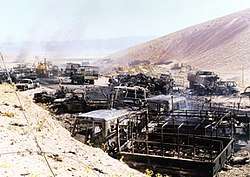
Meanwhile, as the Iraqis were planning their strike, the Iranians continued to attack. 1987 saw a renewed series of major Iranian human wave offensives in both northern and southern Iraq. The Iraqis had elaborately fortified Basra with 5 defensive rings, exploiting natural waterways such as the Shatt-al-Arab and artificial ones, such as Fish Lake and the Jasim River, along with earth barriers. Fish Lake was a massive lake filled with mines, underwater barbed wire, electrodes and sensors. Behind each waterway and defensive line was radar-guided artillery, ground attack aircraft and helicopters; all capable of firing poison gas or conventional munitions.[7]
The Iranian strategy was to penetrate the Iraqi defences and encircle Basra, cutting off the city as well as the Al-Faw peninsula from the rest of Iraq.[54] Iran's plan was for three assaults: a diversionary attack near Basra, the main offensive and another diversionary attack using Iranian tanks in the north to divert Iraqi heavy armor from Basra.[7] For these battles, Iran had re-expanded their military by recruiting many new Basij and Pasdaran volunteers.[54] Iran brought 150,000–200,000 total troops into the battles.[17]
Karbala operations
Operation Karbala-4
On 25 December 1986, Iran launched Operation Karbala-4 (Karbala referring to Hussein ibn Ali's Battle of Karbala).[74] According to Iraqi General Ra'ad al-Hamdani, this was a diversionary attack.[28] The Iranians launched an amphibious assault against the Iraqi island of Umm al-Rassas in the Shatt-Al-Arab river, parallel to Khoramshahr; they then set up a pontoon bridge and continued the attack, eventually capturing it in a costly success and failing to advance further; the Iranians had 60,000 casualties, while the Iraqis 9,500.[50] The Iraqi commanders exaggerated Iranian losses to Saddam and it was assumed that the main Iranian attack on Basra had been fully defeated and that it would take the Iranians six months to recover. When the main Iranian attack, Operation Karbala 5 began, many Iraqi troops were on leave.[28]
Operation Karbala-5 (Sixth Battle of Basra)
The Siege of Basra, code-named Operation Karbala-5 (Persian: عملیات کربلای ۵), was an offensive operation carried out by Iran in an effort to capture the Iraqi port city of Basra in early 1987. This battle, known for its extensive casualties and ferocious conditions, was the biggest battle of the war and proved to be the beginning of the end of the Iran–Iraq War.[75][76]
Operation Karbala-6
At the same time as Operation Karbala 5, Iran also launched Operation Karbala-6 against the Iraqis in Qasr-e Shirin in central Iran to prevent the Iraqis from rapidly transferring units down to defend against the Karbala-5 attack. The attack was carried out by Basij infantry and the Revolutionary Guard's 31st Ashura and the Army's 77th Khorasan armored divisions. The Basij attacked the Iraqi lines, forcing the Iraqi infantry to retreat. An Iraqi armored counter-attack surrounded the Basij in a pincer movement, but the Iranian tank divisions attacked, breaking the encirclement. The Iranian attack was finally stopped by mass Iraqi chemical weapons attacks.[77]
Iranian war-weariness
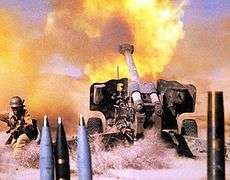
Operation Karbala-5 was a severe blow to Iran's military and morale.[46] To foreign observers, it appeared that Iran was continuing to strengthen. By 1988, Iran had become self-sufficient in many areas, such as anti-tank TOW missiles, Scud ballistic missiles (Shahab-1), Silkworm anti-ship missiles, Oghab tactical rockets, and producing spare parts for their weaponry. Iran had also improved its air defenses with smuggled surface to air missiles.[7] Iran even was producing UAV's and the Pilatus PC-7 propeller aircraft for observation.[7] Iran also doubled their stocks of artillery, and was self-sufficient in manufacture of ammunition and small arms.[78]
While it was not obvious to foreign observers, the Iranian public had become increasingly war-weary and disillusioned with the fighting, and relatively few volunteers joined the fight in 1987–88. Because the Iranian war effort relied on popular mobilization, their military strength actually declined, and Iran was unable to launch any major offensives after Karbala-5. As a result, for the first time since 1982, the momentum of the fighting shifted towards the regular army. Since the regular army was conscription based, it made the war even less popular. Many Iranians began to try to escape the conflict. As early as May 1985, anti-war demonstrations took place in 74 cities throughout Iran, which were crushed by the regime, resulting in some protesters being shot and killed.[79] By 1987, draft-dodging had become a serious problem, and the Revolutionary Guards and police set up roadblocks throughout cities to capture those who tried to evade conscription. Other people (including the more nationalistic and religious) as well as the clergy, and the Revolutionary Guards, wished to continue the war.
The leadership acknowledged that the war was a stalemate, and began to plan accordingly.[17] There were no more "final offensives" planned.[7] The head of the Supreme Defense Council Hashemi Rafsanjani announced during a news conference to finally end the use of human wave attacks.[80] Mohsen Rezaee, head of the IRGC, announced that Iran would focus exclusively on limited attacks and infiltrations, while arming and supporting opposition groups inside of Iraq.[54]
On the Iranian home front, the combination of sanctions, declining oil prices, and Iraqi attacks on Iranian oil facilities and shipping took a heavy toll on the economy. While the attacks themselves were not as destructive as some analysts believed, the U.S.-led Operation Earnest Will (which protected Iraqi and allied oil tankers, but not Iranian ones) led many neutral countries to stop trading with Iran because of rising insurance and fear of air attack.[7][37] Iranian oil and non-oil exports fell by 55%, inflation reached 50% by 1987, and unemployment skyrocketed.[7] At the same time, Iraq was experiencing crushing debt and shortages of workers, encouraging its leadership to try to end the war quickly.[46]
Strategic situation in late 1987
By the end of 1987, Iraq possessed 5,550 tanks (outnumbering the Iranians six to one) and 900 fighter aircraft (outnumbering the Iranians ten to one).[7] After Operation Karbala-5, Iraq only had 100 qualified fighter pilots remaining; therefore, Iraq began to invest in recruiting foreign pilots from countries such as Belgium, South Africa, Pakistan, East Germany and the Soviet Union.[81] They replenished their manpower by integrating volunteers from other Arab countries into their army. Iraq also became self-sufficient in chemical weapons and some conventional ones and received much equipment from abroad.[7] Foreign support helped Iraq bypass its economic troubles and massive debt to continue the war and increase the size of its military.[7]
While the southern and central fronts were at a stalemate, Iran began to focus on carrying out offensives in northern Iraq with the help of the Peshmerga (Kurdish insurgents). The Iranians used a combination of semi-guerrilla and infiltration tactics in the Kurdish mountains with the Peshmerga. During Operation Karbala-9 in early April, Iran captured territory near Suleimaniya, provoking a severe poison gas counter-attack. During Operation Karbala-10, Iran attacked near the same area, capturing more territory. During Operation Nasr-4, the Iranians surrounded the city of Suleimaniya and with the help of the Peshmerga infiltrated over 140 km into Iraq and raided and threatened to capture the oil-rich city of Kirkuk and other northern oilfields.[46] Nasr-4 was considered to be Iran's most successful individual operation of the war but Iranian forces were unable to consolidate their gains and continue their advance; while these offensives coupled with the Kurdish uprising sapped Iraqi strength, losses in the north would not mean a catastrophic failure for Iraq.
On 20 July, the UN Security Council passed the U.S.-sponsored Resolution 598, which called for an end to the fighting and a return to pre-war boundaries.[13] This resolution was noted by Iran for being the first resolution to call for a return to the pre-war borders, and setting up a commission to determine the aggressor and compensation.
Air and tanker war in 1987
With the stalemate on land, the air/tanker war began to play an increasingly major role in the conflict.[72] The Iranian air force had become very small, having only 20 F-4 Phantoms, 20 F-5 Tigers, and 15 F-14 Tomcats in operation. Despite that, Iran managed to restore some damaged planes into service. The Iranian Air Force, despite its once sophisticated equipment, lacked enough equipment and personnel to sustain the war of attrition that had arisen, and was unable to lead an outright onslaught against Iraq.[55] The Iraqi Air Force, however, had originally lacked modern equipment and experienced pilots, but after pleas from Iraqi military leaders, Saddam decreased political influence on everyday operations and left the fighting to his combatants. The Soviets began delivering more advanced aircraft and weapons to Iraq, while the French improved training for flying crews and technical personnel and continually introduced new methods for countering Iranian weapons and tactics.[55] Iranian ground air defense still shot down many Iraqi aircraft.[7][55]
The main Iraqi air effort had shifted to the destruction of Iranian war-fighting capability (primarily Persian Gulf oil fields, tankers, and Kharg Island) and starting late 1986, the Iraqi Air Force moved on a comprehensive campaign against the Iranian economic infrastructure.[55] By late 1987, the Iraqi Air Force could count on direct American support for conducting long-range operations against Iranian infrastructural targets and oil installations deep in the Persian Gulf. U.S. Navy ships tracked and reported movements of Iranian shipping and defences. In the massive Iraqi air strike against Kharg Island, flown on 18 March 1988 the Iraqis destroyed two supertankers but lost five aircraft to Iranian F-14 Tomcats, including two Tupolev Tu-22Bs and one Mikoyan MiG-25RB.[55] The U.S. Navy was now becoming more involved in the fight in the Persian Gulf, launching Operations Earnest Will and Prime Chance against the Iranians.
The attacks on oil tankers continued. Both Iran and Iraq carried frequent attacks during the first four months of the year. Iran was effectively waging a naval guerilla war with its IRGC navy speedboats, while Iraq attacked with its aircraft. In 1987, Kuwait asked to reflag its tankers to the U.S. flag. They did so in March, and the U.S. Navy began Operation Earnest Will to escort the tankers.[72] The result of Earnest Will would be that while oil tankers shipping Iraqi/Kuwaiti oil were protected, Iranian tankers, and neutral tankers shipping to Iran would be unprotected, resulting in both losses for Iran and the undermining of its trade with foreign countries, damaging Iran's economy further. Iran also deployed Silkworm missiles to attack some ships, but only a few were actually fired. Both the United States and Iran jockeyed for influence in the Gulf. To discourage the United States from escorting tankers, Iran secretly mined some areas in the Gulf. The United States began to escort the reflagged tankers, but one of them was damaged by a mine while under escort. While being a public-relations victory for Iran, the United States increased its reflagging efforts. While Iran mined the Persian Gulf, their speedboat attacks were reduced, primarily attacking unflagged tankers shipping in the area.[72]
On 24 September, US Navy SEALS captured the Iranian mine-laying ship Iran Ajr, a diplomatic disaster for the already isolated Iranians. On 8 October, the U.S. Navy destroyed four Iranian speedboats, and in response to Iranian Silkworm missile attacks on Kuwaiti oil tankers, launched Operation Nimble Archer, destroying two Iranian oil rigs in the Persian Gulf.[7] During November and December, the Iraqi air force launched a bid to destroy all Iranian airbases in Khuzestan and the remaining Iranian air force. Iran managed to shoot down 30 Iraqi fighters with fighter jets, anti-aircraft guns, and missiles, allowing the Iranian air force to survive to the end of the war.[7]
On 28 June, Iraqi fighter bombers attacked the Iranian town of Sardasht near the border, using chemical mustard gas bombs. While many towns and cities had been bombed before, and troops attacked with gas, this was the first time that the Iraqis had attacked a civilian area with poison gas.[82] One quarter of the town's then population of 20,000 was burned and stricken, and 113 were killed immediately, with many more dying and suffering health effects over the next decades.[66] Saddam ordered the attack in order to test the effects of the newly developed "dusty mustard" gas, which was designed to be even more crippling than traditional mustard gas. While little known outside of Iran (unlike the later Halabja chemical attack), the Sardasht bombing (and future similar attacks) had a tremendous effect on the Iranian people's psyche.
1988: Iraqi offensives and UN ceasefire
By 1988, with massive equipment imports and reduced Iranian volunteers, Iraq was ready to launch major offensives against Iran.[17] In February 1988, Saddam began the fifth and most deadly "war of the cities".[2] Over the next two months, Iraq launched over 200 al-Hussein missiles at 37 Iranian cities.[2][78] Saddam also threatened to use chemical weapons in his missiles, which caused 30% of Tehran's population to leave the city.[2] Iran retaliated, launching at least 104 missiles against Iraq in 1988 and shelling Basra.[50][78] This event was nicknamed the "Scud Duel" in the foreign media.[7] In all, Iraq launched 520 Scuds and al-Husseins against Iran and Iran fired 177 at them. The Iranian attacks were too few in number to deter Iraq from launching their attacks.[78] Iraq also increased their airstrikes against Kharg Island and Iranian oil tankers. With their allies tankers protected by U.S. warships, they could operate with virtual impunity.[7][72] To make matters worse, the West supplied Iraq's air force with laser-guided smart bombs, allowing them to attack economic targets while evading anti-aircraft defenses. These attacks began to have a major toll on the Iranian economy, morale, and caused many casualties as well.[7][35][72]
Iran's Kurdistan Operations
In March 1988, the Iranians carried out Operation Dawn 10, Operation Beit ol-Moqaddas 2, Operation Beit ol-Moqaddas 3, Operation Beit ol-Moqaddas 4, and Operation Zafar 7 in Iraqi Kurdistan with the aim of capturing the Darbandikhan Dam and the power plant at Lake Dukan, which supplied Iraq with much of its electricity and water, as well as the city of Suleimaniya.[5]:264 Iran hoped that the capture of these areas would bring more favorable terms to the ceasefire agreement.[35] This infiltration offensive was carried out in conjunction with the Peshmerga. Iranian airborne commandos landed behind the Iraqi lines and Iranian helicopters hit Iraqi tanks with TOW missiles. The Iraqis were taken by surprise, and Iranian F-5E Tiger fighter jets even damaged the Kirkuk oil refinery.[7] Iraq carried out executions of multiple officers for these failures in March–April 1988, including Colonel Jafar Sadeq.[28] The Iranians used infiltration tactics in the Kurdish mountains, captured the town of Halabja and began to fan out across the province.[28]
Though the Iranians advanced to within sight of Dukan and captured around 1,040 km2 (400 sq mi) and 4,000 Iraqi troops, the offensive failed due to the Iraqi use of chemical warfare.[5]:264 The Iraqis launched the deadliest chemical weapons attacks of the war. The Republican Guard launched 700 chemical shells, while the other artillery divisions launched 200–300 chemical shells each, unleashing a chemical cloud over the Iranians, killing or wounding 60% of them, the blow was felt particularly by the Iranian 84th infantry division and 55th paratrooper division.[28] The Iraqi special forces then stopped the remains of the Iranian force.[28] In retaliation for Kurdish collaboration with the Iranians, Iraq launched a massive poison gas attack against Kurdish civilians in Halabja, recently taken by the Iranians, killing thousands of civilians.[83] Iran airlifted foreign journalists to the ruined city, and the images of the dead were shown throughout the world but Western mistrust of Iran and collaboration with Iraq led them to also blame Iran for the attack. At one point, the United States claimed that Iran had launched the attack and then tried to blame Iraq for it.[83]
Second Battle of al-Faw
On 17 April 1988, Iraq launched Operation Ramadan Mubarak (Blessed Ramadan), a surprise attack against the 15,000 Basij troops on the peninsula.[17] The attack on al-Faw was preceded by Iraqi diversionary attacks in northern Iraq, with a massive artillery and air barrage of Iranian front lines. Key areas, such as supply lines, command posts, and ammunition depots, were hit by a storm of mustard gas and nerve gas, as well as by conventional explosives. Helicopters landed Iraqi commandos behind Iranian lines while the main Iraqi force attacked in a frontal assault. Within 48 hours, all of the Iranian forces had been killed or cleared from the al-Faw Peninsula.[17] The day was celebrated in Iraq as Faw Liberation Day throughout Saddam's rule. The Iraqis had planned the offensive well. Prior to the attack the Iraqi soldiers gave themselves poison gas antidotes to shield themselves from the effect of the saturation of gas. The heavy and well executed use of chemical weapons was the decisive factor in the Iraqi victory.[84] Iraqi losses were relatively light, especially compared to Iran's casualties.[28] The Iranians eventually managed to halt the Iraqi drive as they pushed towards Khuzestan.[7]
To the shock of the Iranians, rather than breaking off the offensive, the Iraqis kept up their drive, and a new force attacked the Iranian positions around Basra.[2] Following this, the Iraqis launched a sustained drive to clear the Iranians out of all of southern Iraq.[5]:264 One of the most successful Iraqi tactics was the "one-two punch" attack using chemical weapons. Using artillery, they would saturate the Iranian front line with rapidly dispersing cyanide and nerve gas, while longer-lasting mustard gas was launched via fighter-bombers and rockets against the Iranian rear, creating a "chemical wall" that blocked reinforcement.[7]
Operation Praying Mantis
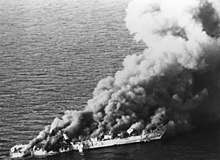
The same day as Iraq's attack on al-Faw peninsula, the United States Navy launched Operation Praying Mantis in retaliation against Iran for damaging a warship with a mine. Iran lost oil platforms, destroyers, and frigates in this battle, which ended only when President Reagan decided that the Iranian navy had been put down enough. In spite of this, the Revolutionary Guard Navy continued their speedboat attacks against oil tankers.[17] The defeats at al-Faw and in the Persian Gulf nudged Iranian leadership towards quitting the war, especially when facing the prospect of fighting the Americans.[17]
Iranian counteroffensive
Faced with such losses, Khomeini appointed the cleric Hashemi Rafsanjani as the Supreme Commander of the Armed Forces, though he had in actuality occupied that position for months.[78] Rafsanjani ordered a last desperate counter-attack into Iraq, which was launched 13 June 1988. The Iranians infiltrated through the Iraqi trenches and moved 10 km (6.2 mi) into Iraq and managed to strike Saddam's presidential palace in Baghdad using fighter aircraft.[7] After three days of fighting, the decimated Iranians were driven back to their original positions again as the Iraqis launched 650 helicopter and 300 aircraft sorties.[78]
Operation Forty Stars
On 18 June, Iraq launched Operation Forty Stars (چل چراغ chehel cheragh) in conjunction to the Mujahideen-e-Khalq (MEK) around Mehran. With 530 aircraft sorties and heavy use of nerve gas, they crushed the Iranian forces in the area, killing 3,500 and nearly destroying a Revolutionary Guard division.[78] Mehran was captured once again and occupied by the MEK.[78] Iraq also launched air raids on Iranian population centers and economic targets, setting 10 oil installations on fire.[78]
Tawakalna ala Allah operations
On 25 May 1988, Iraq launched the first of five Tawakalna ala Allah (Trust in God) Operations,[28] consisting of one of the largest artillery barrages in history, coupled with chemical weapons. The marshes had been dried by drought, allowing the Iraqis to use tanks to bypass Iranian field fortifications, expelling the Iranians from the border town of Shalamcheh after less than 10 hours of combat.[2]:11[5]:265[78]
On 25 June, Iraq launched the second Tawakal ala Allah operation against the Iranians on Majnoon Island. Iraqi commandos used amphibious craft to block the Iranian rear,[7] then used hundreds of tanks with massed conventional and chemical artillery barrages to recapture the island after 8 hours of combat.[28][78] Saddam appeared live on Iraqi television to "lead" the charge against the Iranians.[78] The majority of the Iranian defenders were killed during the quick assault.[28] The final two Tawakal ala Allah operations took place near al-Amarah and Khaneqan.[28] By 12 July, the Iraqis had captured the city of Dehloran, 30 km (19 mi) inside Iran, along with 2,500 troops and much armour and material, which took four days to transport to Iraq. These losses included more than 570 of the 1,000 remaining Iranian tanks, over 430 armored vehicles, 45 self-propelled artillery, 300 towed artillery pieces, and 320 antiaircraft guns. These figures only included what Iraq could actually put to use; total amount of captured materiel was higher. Since March, the Iraqis claimed to captured 1,298 tanks, 155 infantry fighting vehicles, 512 heavy artillery pieces, 6,196 mortars, 5,550 recoilless rifles and light guns, 8,050 man-portable rocket launchers, 60,694 rifles, 322 pistols, 454 trucks, and 1,600 light vehicles.[78] The Iraqis withdrew from Dehloran soon after, claiming that they had "no desire to conquer Iranian territory."[7] History professor Kaveh Farrokh considered this to be Iran's greatest military disaster during the war. Stephen Pelletier, a Journalist, Middle East expert, and Author, noted that "Tawakal ala Allah … resulted in the absolute destruction of Iran's military machine."[7]
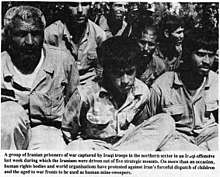
During the 1988 battles, the Iranians put up little resistance to the Iraqi offensives, having been worn out by nearly eight years of war.[5]:253 They lost large amounts of equipment but they managed to rescue most of their troops from being captured by the Iraqis, leaving Iraq with relatively few prisoners.[7] On 2 July, Iran belatedly set up a joint central command which unified the Revolutionary Guard, Army, and Kurdish rebels, and dispelled the rivalry between the Army and the Revolutionary Guard. However, this came too late, and due to the capture of 570 of their operable tanks and the destruction of hundreds more, Iran was believed to have fewer than 200 remaining operable tanks on the southern front, faced against thousands of Iraqi ones.[78] The only area where the Iranians were not suffering major defeats was in Kurdistan.[46]
Iran accepts the ceasefire
Saddam sent a warning to Khomeini in mid-1988, threatening to launch a new and powerful full-scale invasion and attack Iranian cities with weapons of mass destruction. Shortly afterwards, Iraqi aircraft bombed the Iranian town of Oshnavieh with poison gas, immediately killing and wounding over 2,000 civilians. The fear of an all out chemical attack against Iran's largely unprotected civilian population weighed heavily on the Iranian leadership, and they realized that the international community had no intention of restraining Iraq.[86] The lives of the civilian population of Iran were becoming very disrupted, with a third of the urban population evacuating major cities in fear of the seemingly imminent chemical war. Meanwhile, Iraqi conventional bombs and missiles continuously hit towns and cities, as well as destroyed vital civilian and military infrastructure, and the death toll increased. Iran did reply with missile and air attacks as well, but not enough to deter the Iraqis from attacking.[78]
Under the threat of a new and even more powerful invasion, Commander-in-Chief Rafsanjani ordered the Iranians to retreat from Haj Omran, Kurdistan on 14 July.[78][87] The Iranians did not publicly describe this as a retreat, instead calling it a "temporary withdrawal".[87] By July, Iran's army inside Iraq (except Kurdistan) had largely disintegrated.[7] Iraq put up a massive display of captured Iranian weapons in Baghdad, claiming they captured 1,298 tanks, 5,550 recoil-less rifles, and thousands of other weapons.[78] However, Iraq had taken heavy losses as well, and the battles were very costly.[28]
In July 1988, Iraqi aircraft dropped bombs on the Iranian Kurdish village of Zardan. Dozens of villages, such as Sardasht, and some larger towns, such as Marivan, Baneh and Saqqez,[88] were once again attacked with poison gas, resulting in even heavier civilian casualties.[89] About the same time, the USS Vincennes shot down Iran Air Flight 655, killing 290 passengers and crew. The lack of international sympathy disturbed the Iranian leadership, and they came to the conclusion that the United States was on the verge of waging a full-scale war against them, and that Iraq was on the verge of unleashing its entire chemical arsenal upon their cities.[86]
At this point, elements of the Iranian leadership, led by Rafsanjani (who had initially pushed for the extension of the war), persuaded Khomeini to accept the ceasefire.[2] They stated that in order to win the war, Iran's military budget would have to be increased by 700% and the war would last until 1993.[78] On 20 July 1988, Iran accepted Resolution 598, showing its willingness to accept a ceasefire.[2]:11 A statement from Khomeini was read out in a radio address, and he expressed deep displeasure and reluctance about accepting the ceasefire,
Happy are those who have departed through martyrdom. Happy are those who have lost their lives in this convoy of light. Unhappy am I that I still survive and have drunk the poisoned chalice...[2][36]:1
The news of the end of the war was greeted with celebration in Baghdad, with people dancing in the streets; in Tehran, however, the end of the war was greeted with a somber mood.[36]:1
Operation Mersad and end of the war
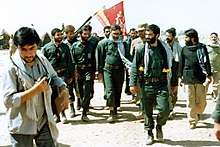
Operation Mersad (مرصاد "ambush") was the last big military operation of the war. Both Iran and Iraq had accepted Resolution 598 but despite the ceasefire, after seeing Iraqi victories in the previous months, Mujahadeen-e-Khalq (MEK) decided to launch an attack of its own and wished to advance all the way to Teheran. Saddam and the Iraqi high command decided on a two pronged offensive across the border into central Iran and Iranian Kurdistan.[7] Shortly after Iran accepted the ceasefire the MEK army began its offensive, attacking into Ilam province under cover of Iraqi air power. In the north, Iraq also launched an attack into Iraqi Kurdistan, which was blunted by the Iranians.[7]
On 26 July 1988, the MEK started their campaign in central Iran, Operation Forough Javidan (Eternal Light), with the support of the Iraqi army. The Iranians had withdrawn their remaining soldiers to Khuzestan in fear of a new Iraqi invasion attempt, allowing the Mujahedeen to advance rapidly towards Kermanshah, seizing Qasr-e Shirin, Sarpol-e Zahab, Kerend-e Gharb, and Islamabad-e-Gharb. The MEK expected the Iranian population to rise up and support their advance; the uprising never materialised but they reached 145 km (90 mi) deep into Iran. In response, the Iranian military launched its counter-attack, Operation Mersad, under Lieutenant General Ali Sayyad Shirazi. Iranian paratroopers landed behind the MEK lines while the Iranian Air Force and helicopters launched an air attack, destroying much of the enemy columns.[7] The Iranians defeated the MEK in the city of Kerend-e Gharb on 29 July 1988.[78] On 31 July, Iran drove the MEK out of Qasr-e-Shirin and Sarpol Zahab, though MEK claimed to have "voluntarily withdrawn" from the towns.[7][78] Iran estimated that 4,500 MEK were killed, while 400 Iranian soldiers died.[90]
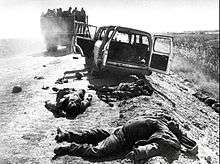
The last notable combat actions of the war took place on 3 August 1988, in the Persian Gulf when the Iranian navy fired on a freighter and Iraq launched chemical attacks on Iranian civilians, killing an unknown number of them and wounding 2,300.[78] Iraq came under international pressure to curtail further offensives. Resolution 598 became effective on 8 August 1988, ending all combat operations between the two countries.[87] By 20 August 1988, peace with Iran was restored.[87] UN peacekeepers belonging to the UNIIMOG mission took the field, remaining on the Iran–Iraq border until 1991. The majority of Western analysts believe that the war had no winners while some believed that Iraq emerged as the victor of the war, based on Iraq's overwhelming successes between April and July 1988.[7] Others can argue that Iran was the victor after successfully defending their country from invasion and repelling the aggressor despite being isolated and under international sanctions and while their enemy was exceptionally well funded and supported. While the war was now over, Iraq spent the rest of August and early September clearing the Kurdish resistance. Using 60,000 troops along with helicopter gunships, chemical weapons (poison gas), and mass executions, Iraq hit 15 villages, killing rebels and civilians, and forced tens of thousands of Kurds to relocate to settlements.[78] Many Kurdish civilians fled to Iran. By 3 September 1988, the anti-Kurd campaign ended, and all resistance had been crushed.[78] 400 Iraqi soldiers and 50,000–100,000 Kurdish civilians and soldiers had been killed.[78][91]
At the war's conclusion, it took several weeks for the Armed Forces of the Islamic Republic of Iran to evacuate Iraqi territory to honor pre-war international borders set by the 1975 Algiers Agreement.[7] The last prisoners of war were exchanged in 2003.[92][93]
The Security Council did not identify Iraq as the aggressor of the war until 11 December 1991, some 12 years after Iraq invaded Iran and 16 months following Iraq's invasion of Kuwait.[94][95]
Notes
- Called Arvand Rood (اروندرود) in Iran and Shatt al-Arab (شط العرب) in Iraq
- Muslim ibn Aqil referring to the Muslim figure
- Muharram referring to the first month of the Islamic calendar, during which the operation took place[49]
References
- Veisi, Morad. "بازخوانی ۹۶ ماه نبرد زمینی ایران و عراق". BBC. Archived from the original on 2015-09-24. Retrieved 22 September 2015.
- Karsh, Efraim (25 April 2002). The Iran–Iraq War: 1980–1988. Osprey Publishing. pp. 1–8, 12–16, 19–82. ISBN 978-1-84176-371-2.
- Cordesman, Anthony H.; Wagner, Abraham (1990). The Lessons of Modern War: Volume Two – The Iran–Iraq Conflict. Westview Press. p. 102. ISBN 978-0-8133-0955-2.
- Cruze, Gregory S. (Spring 1988). "Iran and Iraq: Perspectives in Conflict". Military Reports. Archived from the original on 2016-01-01. Retrieved 2018-11-17.
- Brogan, Patrick (1989). World Conflicts: A Comprehensive Guide to World Strife Since 1945. London: Bloomsbury. ISBN 0-7475-0260-9.
- Robinson, Julian Perry; Goldbat, Jozef (May 1984). "Chemical Warfare in the Iran–Iraq War 1980–1988". History of Iran. Iran Chamber Society. Archived from the original on 2016-01-01. Retrieved 2018-11-17.
- Farrokh, Kaveh. Iran at War: 1500–1988. Oxford: Osprey Publishing. ISBN 978-1-78096-221-4.
- Cooper, Thomas; Bishop, Farzad (9 September 2003). "Persian Gulf War: Iraqi Invasion of Iran, September 1980". Arabian Peninsula and Persian Gulf Database. Air Combat Information Group. Archived from the original on 2014-02-21. Retrieved 2018-11-17.
- Modern Warfare: Iran–Iraq War (film documentary).
- Wilson, Ben. "The Evolution of Iranian Warfighting during the Iran–Iraq War" (PDF). Archived from the original (PDF) on 29 October 2013.
- Eckholm, Leif (1 August 2011). "Invading Iran: Lessons From Iraq". Policy Review. Stanford University Hoover Institution. 168. Archived from the original on 2013-05-08. Retrieved 2018-11-17.
Invading forces would need to be prepared for a deeply embedded and enduring insurgency, due to extreme challenges presented by terrain, and resolve...
- Wilson, Ben (July–August 2007). "The Evolution of Iranian Warfighting During the Iran-Iraq War: When Dismounted Light Infantry Made the Difference" (PDF). U.S. Army: Foreign Military Studies Office. Archived from the original (PDF) on 29 October 2013. Cite journal requires
|journal=(help) - Pike, John (ed.). "Iran–Iraq War (1980–1988)". Archived from the original on 2011-02-28. Retrieved 2018-11-17.
- Aboul-Enein, Youssef; Bertrand, Andrew; Corley, Dorothy (12 April 2012). "Egyptian Field Marshal Abdul-Halim Abu Ghazalah on the Combat Tactics and Strategy of the Iran–Iraq War". Small Wars Journal. Ghazalah's Phased Analysis of Combat Operations. Small Wars Foundation. Archived from the original on 2016-01-01. Retrieved 2018-11-17.
- Tucker, A. R. (1988). Armored warfare in the Gulf. Armed Forces, May, pp.226.
- "Irano-Irakskii konflikt. Istoricheskii ocherk." Niyazmatov. J.A. — M.: Nauka, 1989.
- Pollack, Kenneth M. (2004). "Iraq". Arabs at War: Military Effectiveness, 1948–1991. Lincoln: University of Nebraska Press. ISBN 978-0-8032-8783-9.
- Dennis, Simon Dunstan (2009). The Six Day War, 1967: Jordan and Syria (1st ed.). Oxford: Osprey Publishing. p. 22. ISBN 978-1-84603-364-3.
- Jafari, Mojtaba. "Nasr Offensive Operation". Archived from the original on 2014-07-15. Retrieved 2018-11-17.
- In 1984 Bani-Sadr left the coalition because of a dispute with Rajavi. Abolhassan Banisadr (Farsi) ابوالحسن بنیصدر approved in the final line of : http://www.britannica.com/EBchecked/topic/51848/Abolhasan-Bani-Sadr Archived 2015-05-04 at the Wayback Machine
- Massoud Rajavi
- "Iran-Iraq war bogs down in rain, conflicting claims". CSMonitor.com. Archived from the original on 2013-12-31. Retrieved 5 October 2013.
- "Assault on Al-Wallid". Imperial Iraniasn Air Force. Archived from the original on 2017-10-11. Retrieved 2018-11-17.
- Cordesman, Anthony. "Lessons of Modern Warfare: The Iran Iraq War Chapter V" (PDF). Archived (PDF) from the original on 2009-09-11. Retrieved 2018-11-17.
- Cooper, Tom. "Bombed by Blinders Part 1". Archived from the original on 2017-06-30. Retrieved 2018-11-17.
- Khomeini: life of the Ayatollah By Baqer Moin
- Pelletiere, Stephen. The Iran–Iraq War: Chaos in a Vacuum.
- Woods, Kevin. "Saddam's Generals: A Perspective of the Iran–Iraq War" (PDF). Archived from the original (PDF) on 3 April 2013.
- Iran Yearbook. Moini-Biontino. 1988. p. 125. LCCN sn89044105.
- "Tactical Evolution In The Iraqi Army: The Abadan Island And Fish Lake Campaigns Of The Iran-Ipaq War" (PDF). Archived (PDF) from the original on 2013-12-03. Retrieved 2014-08-18.
- Firestone, Reuven (2008). Who are the real chosen people?: The Meaning of Chosenness in Judaism, Christianity, and Islam (2008 hardcover ed.). Woodstock, VT: SkyLight Paths Publishing. p. 143. ISBN 978-1-59473-248-5.
- "Iran at war". Reuters. 31 May 2012. Archived from the original on 8 August 2014. cited in Farrokh, Kaveh. "Review: Wall Street Journal and Reuters". Archived from the original on 2018-08-16. Retrieved 2018-11-17.
- Keegan, John (2004). The Iraq war. New York: Knopf. ISBN 978-1-4000-4199-2.
- Thomas Cooper and Farzad Bishop (9 September 2003). "Fire in the Hills: Iranian and Iraqi Battles of Autumn 1982". Arabian Peninsula & Persian Gulf Database. Air Combat Information Group. Archived from the original on 2014-08-22. Retrieved 2018-11-17.
- "Viewpoints of the Iranian political and military elites". Archived from the original on 2016-03-03. Retrieved 2018-11-17.
- Bulloch, John; Morris, Harvey (1989). The Gulf War: Its Origins, History and Consequences (1st published ed.). London: Methuen. ISBN 978-0-413-61370-7.
- "Iran-Iraq War 1980–1988". History of Iran. Iran Chamber Society. Archived from the original on 2010-01-15. Retrieved 2018-11-17.
- Williams, Scott (June 2002). "The Battle of al-Khafji". Monterey, California: Naval Postgraduate School. Archived from the original on 2013-04-13. Retrieved 2018-11-17. Cite journal requires
|journal=(help) - "Declaration of Howard Teicher" (PDF). Case No. 93-241-CR-HIGHSMITH. United States District Court: Southern District Florida. 31 January 1995. Archived (PDF) from the original on 2012-04-24. Retrieved 2018-11-17. Plain text version
- "Importer/Exporter TIV Tables". armstrade.sipri.org. Archived from the original on 2011-07-28. Retrieved 2018-11-17.
- Jupp, Michael (19 December 1988). "Child-Soldier Treaty Has Wide Support". The New York Times. Archived from the original on 2018-09-15. Retrieved 2018-11-17.
- Special to The Christian Science Monitor. "Giving one's life to the cause of Islam and Iran. Guarding the revolution's Islamic standards". CSMonitor.com. Archived from the original on 2013-10-07. Retrieved 5 October 2013.
- IRAQ VOWS TO QUIT IRAN, FIGHT ISRAEL Archived 2018-11-16 at the Wayback Machine AP 10 June 1982
- IRAN SAYS IRAQIS' WITHDRAWAL WON'T END WAR Archived 2017-10-23 at the Wayback Machine New York Times 22 June 1982
- Cordesman, Anthony H. (1999). Iraq and the War of Sanctions: Conventional Threats and Weapons of Mass Destruction (1st published ed.). Westport, Connecticut: Praeger. ISBN 0-275-96528-7.
- Dunn, Brian. "The First Gulf War". Archived from the original on 2018-11-16. Retrieved 2018-11-17.
- O'Ballance, E. (1988). The Gulf War. Brassey's. p.95
- Zabih, S. (1988). The Iranian Military in Revolution and War. New York: Routledge. pp.181
- Naficy, Hamid (2012). A Social History of Iranian Cinema The Globalizing Era, 1984–2010. Duke University Press. p. 11. ISBN 978-0-8223-4878-8.
- Aboul-Enein, Youssef; Bertrand, Andrew; Corley, Dorothy (23 April 2012). "dawn-of-victory"-campaigns-to-the-"final-push"-part-three-of-three "The "Dawn of Victory" campaigns to the "Final Push": Part Three of Three". Small Wars Journal. Small Wars Foundation.
- Bergquist, Ronald E. (1988). The Role of Airpower in the Iran-Iraq War. Alabama: Air University Press. p. 56. ISBN 978-1-234-87718-7.
- Razoux, Pierre (2015). The Iran-Iraq War. Cambridge, MA: The Belknap Press of Harvard University Press. pp. 568–572. ISBN 978-0-674-08863-4.
- Dunn, Brian J. (1998). "The First Gulf War". The Dignified Rant. Archived from the original on 2018-11-16. Retrieved 2018-11-17.
- "Phase Five: New Iranian Efforts at "Final Offensives", 1986–1887". The Lessons of Modern War – Volume II: Iran-Iraq War (PDF). Center for Strategic and International Studies. Archived (PDF) from the original on 2013-06-07. Retrieved 2018-11-17.
- Thomas Coper and Farzad Bishop (9 September 2003). "Persian Gulf War, 1980–1988: The Mother of All Build-Ups". Arabian Peninsula and Persian Gulf Database. Air Combat Information Group. Archived from the original on 2013-11-15. Retrieved 2018-11-17.
- Cordesman, Anthony. "The Lessons of Modern War Vol II". Archived from the original on 2013-07-05. Retrieved 2018-11-17.
- Dugdale-Pointon, T.D.P. (27 October 2002). "Tanker War 1984–1988". Archived from the original on 2010-01-24. Retrieved 2018-11-17.
- Wars in Peace: Iran-Iraq War (film documentary). Wars in Peace. 1995.
- "Attack on USS Stark (FFG-31)" (PDF). JAG Manual Investigations. U.S. Navy Judge Advocate General's Corps. 3 September 1987. Archived (PDF) from the original on 2011-05-01. Retrieved 2018-11-17. Cite journal requires
|journal=(help) - Pokrant, Marvin (1999). Desert Storm at Sea: What the Navy Really Did. Westport, Connecticut: Greenwood Press. p. 43. ISBN 978-0-313-31024-9.
- Kelley, Stephen Andrew (June 2007). "Better Lucky Than Good: Operation Earnest Will as Gunboat Diplomacy". Naval Postgraduate School. ASIN B007U7WRUC. Cite journal requires
|journal=(help) - "Formal Investigation into the Circumstances Surrounding the Attack of the USS Stark in 1987" (PDF). OSD/JS FOIA Library. Office of the Secretary of Defense and Joint Staff. Archived from the original (PDF) on 22 September 2012. Cite journal requires
|journal=(help) - "Iran: Gradual Superpower Involvement". Country Study & Guide. AllRefer. Archived from the original on 2011-06-28. Retrieved 2 August 2011.
- Ross, William. "Seawise Giant". Relevant Search Scotland. Archived from the original on 2011-08-09. Retrieved 2 August 2011.
- Cooper, Tom. "Bombed By Blinders Part 2". Archived from the original on 2017-06-26. Retrieved 2018-11-17.
- Daraghai, Borzou. "1987 Chemical Strike Still Haunts Iran". Los Angeles Times. Archived from the original on 2015-10-15. Retrieved 2018-11-17.
- Rubin, Barry. Conflict and Insurgency in the Middle East.
- Wright, Robin (1989). In the name of God: The Khomeini decade. New York: Simon and Schuster. pp. 126, 133. ISBN 978-0-671-67235-5.
- A speech on 4 April 1985 by Ruhollah Khomeini in Persian quoted in Brumberg, Daniel (2001). Reinventing Khomeini: The Struggle for Reform in Iran. Chicago: University of Chicago Press. pp. 132–134. ISBN 978-0-226-07758-1.
- نگاهی به نقش ناشناخته "تلاش" و "مهاجر" در کربلای 5 و والفجر 8 [Looking at the unrecognised role of (the drones) "effort" and "immigrant" in Dawn Operations 5 and 8]. Mashregnews (in Persian). 2 October 2011. Archived from the original on 2015-10-23. Retrieved 2018-11-17.
- Pollack, Kenneth, M (2002). The Arabs at War: Military Effectiveness, 1948–1991. Lincoln: University of Nebraska Press. p. 217. ISBN 0-8032-3733-2.
- Cordesman, Anthony. "Lessons of Modern War: The Iran-Iraq War" (PDF). Archived (PDF) from the original on 2014-01-04. Retrieved 2018-11-17.
- Rubin, Michael (Spring 2003). "Are Kurds a pariah minority?". Social Research. Pariah Minorities. The New School. 70 (1): 295–330. JSTOR 40971614.
- Silverstein, Adam J. (21 January 2012). Islamic History: A Very Short Introduction. Oxford University Press. ISBN 978-0-19-160934-3.
- Pollack, Kenneth M. (2004). "Iraq". Arabs at War: Military Effectiveness, 1948–1991. Lincoln: University of Nebraska Press. ISBN 9780803287839.
- "www.fatehan.ir". Archived from the original on 2017-10-24. Retrieved 2018-11-17.
- "Iran–Iraq war". Archived from the original on 2012-09-23. Retrieved 13 October 2012.
- "The Combination of Iraqi offensives and Western intervention force Iran to accept a cease-fire: September 1987 to March 1989". The Lessons of Modern War – Volume II: Iran-Iraq War (PDF). Center for Strategic and International Studies. Archived (PDF) from the original on 2013-06-07. Retrieved 2018-11-17.
- "Anti-war protests reported in Iran". Spokane Chronicle. Google News Archive. Associated Press. 10 May 1985.
- Sciolino, Elaine. "Human Wave raid loses Iran's favor". Archived from the original on 2017-11-06. Retrieved 2018-11-17.
- "Archived copy". Archived from the original on 2018-11-16. Retrieved 2018-11-17.CS1 maint: archived copy as title (link)
- Mohammadi, Karim. "The Forgotten Victims of the Iran-Iraq War". Archived from the original on 2017-10-11. Retrieved 2018-11-17.
- "1988: Thousands die in Halabja gas attack". On This Day. BBC. Archived from the original on 2010-03-31. Retrieved 2018-11-17.
- Tyler, Patrick. "Officers Say US Aided Iraq in war despite use of gas". The News York Times. Archived from the original on 2018-01-20. Retrieved 2018-11-17.
- Crist, David (2012). The Twilight War: The secret history of America's thirty-year conflict with Iran. New York: Penguin Press. p. 434 (Photo plates). ISBN 978-1-59420-341-1.
- Iran's strategic intentions and capabilities. DIANE Publishing. p. 211. ISBN 978-1-4289-9255-9.
- Dodds, Joanna; Wilson, Ben (6 June 2009). "The Iran-Iraq War: Unattainable Objectives". Middle East Review of International Affairs. 13 (2). Archived from the original on 6 October 2014. Retrieved 2018-11-17.
- "Archived copy" (PDF). Archived (PDF) from the original on 2016-08-10. Retrieved 2018-11-17.CS1 maint: archived copy as title (link)
- "Iran Reports New Iraqi Gas Raids; And Says Cities May be Hit Next – New York Times". Nytimes.com. 2 April 1988. Archived from the original on 2013-10-07. Retrieved 5 October 2013.
- "Mersad operation". Special Edition. Tebyan. 27 July 2005.
- Wong, Edward (5 April 2006). "Hussein charged with genocide in 50,000 deaths". The New York Times. Archived from the original on 2018-06-24. Retrieved 2018-11-17.
- Molavi, Afshin (2005). The Soul of Iran: A Nation's Journey to Freedom (Revised ed.). England: W. W. Norton & Company. p. 152. ISBN 978-0-393-32597-3.
- Fathi, Nazila (14 March 2003). "Threats And Responses: Briefly Noted; Iran-Iraq Prisoner Deal". The New York Times. Archived from the original on 2018-08-13. Retrieved 2018-11-17.
- Tarock, Adam (1998). The superpowers' involvement in the Iran–Iraq War. Commack, NY: Nova Science Publishers. p. 208. ISBN 978-1-56072-593-0.
- "Iran–Iraq War: Legal and International Dimensions". iranreview.org. Archived from the original on 2018-04-20. Retrieved 2018-11-17.
